
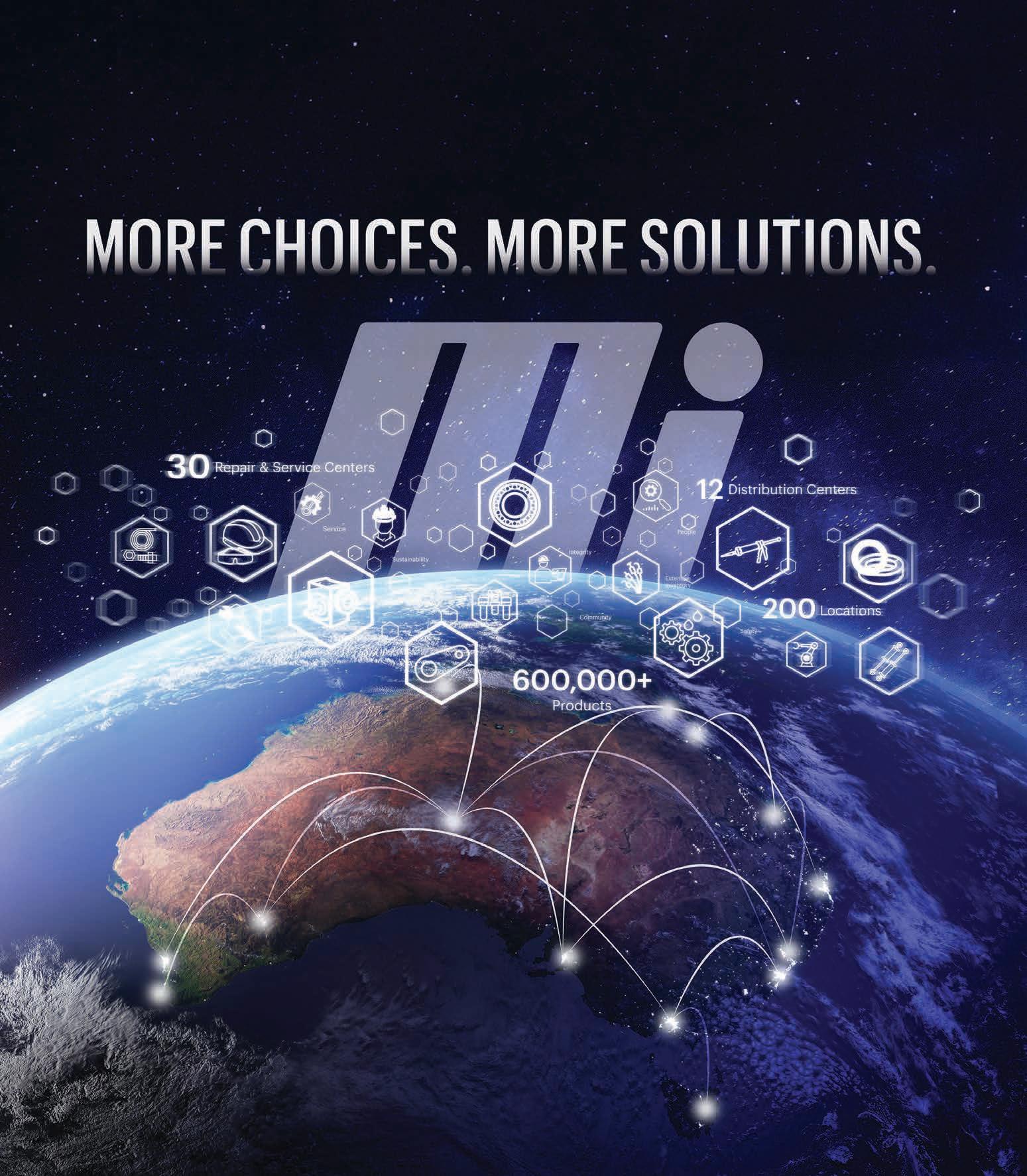
manmonthly.com.au MANAGEMENT >> TECHNOLOGY >> SOLUTIONS

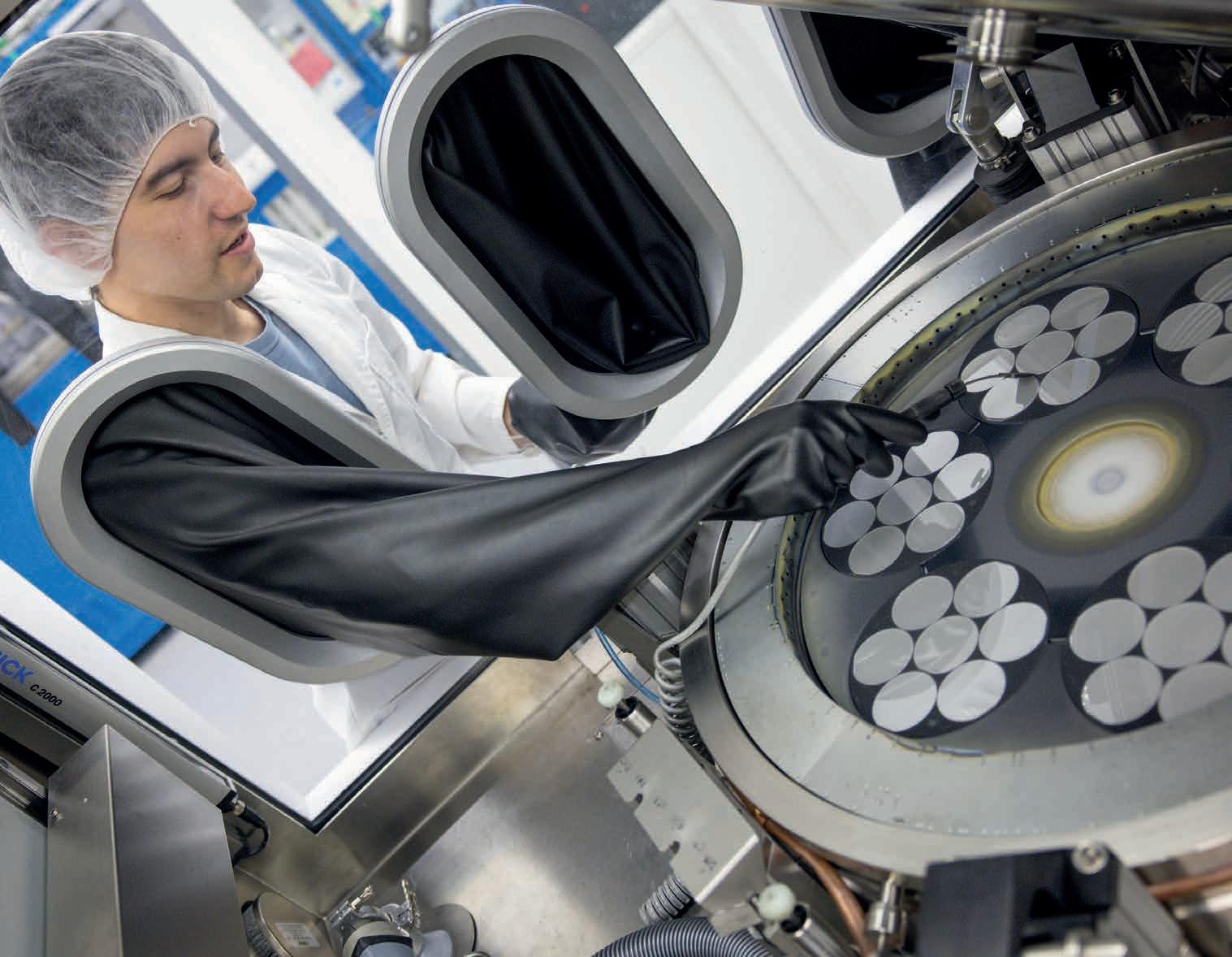






manmonthly.com.au MANAGEMENT >> TECHNOLOGY >> SOLUTIONS APRIL 2024 >> INSIDE >> Endeavour Awards profile 32 SICK sensor technology 28 Official Industry Partners: sem conductor MANUFACTURING TECHNOLOGY FROM to LiDAV from Advanced Navigation 48
CEO: John Murphy
Chief Operating Officer: Christine Clancy
Managing Editor: Syed Shah
Journalist: Phillip Hazell phillip.hazell@primecreative.com.au
Production Coordinator: Michelle Weston michelle.weston@primecreative.com.au
Art Director: Blake Storey
Design: Cat Zappia
Sales/Advertising: Emily Gorgievska
Ph: 0432 083 392 emily.gorgievska@primecreative.com.au
Subscriptions
Published 11 times a year
Subscriptions $140.00 per annum (inc GST) Overseas prices apply
Ph: (03) 9690 8766
Copyright Manufacturers’ Monthly is owned by Prime Creative Media and published by John Murphy.
All material in Manufacturers’ Monthly is copyright and no part may be reproduced or copied in any form or by any means (graphic, electronic or mechanical including information and retrieval systems) without written permission of the publisher. The Editor welcomes contributions but reserves the right to accept or reject any material. While every effort has been made to ensure the accuracy of information, Prime Creative Media will not accept responsibility for errors or omissions or for any consequences arising from reliance on information published.
The opinions expressed in Manufacturers’ Monthly are not necessarily the opinions of, or endorsed by the publisher unless otherwise stated.
© Copyright Prime Creative Media, 2024
Articles All articles submitted for publication become the property of the publisher. The Editor reserves the right to adjust any article to conform with the magazine format.
Head

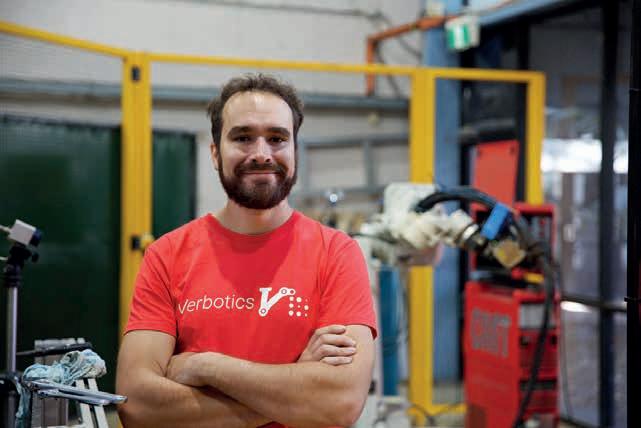
In April’s cover story, we look at BluGlass Limited, a homegrown semiconductor manufacturer. We will see how the company developed overtime, from their humble beginnings at Macquarie University, to the commercialisation of their products. Also in this issue, we check-in with Endeavour Awards nominee, Verbotics, who specialises in software programming for robotics. Later in the issue, we catch up with SEMMA, who offered their thoughts about the recent land taxes in Southeast Melbourne. Finally, in this month’s Engineering Focus, we explore Advanced Navigations LiDAV tech, which is enabling vehicles to navigate autonomously.

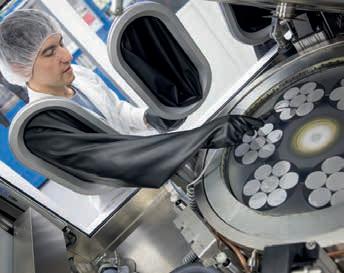



Office 379 Docklands Drive Docklands VIC 3008 P: +61 3 9690 8766 enquiries@primecreative.com.au www.primecreative.com.au Sydney Office Suite 3.06, 1-9 Chandos Street St Leonards NSW 2065, Australia P: +61 2 9439 7227 Printed by: The Precision Group 83-89 Freight Drive. Somerton Vic 3062 Ph: (03) 9794 8337 manmonthly.com.au twitter.com/Manmonthly facebook.com/Manmonthly linkedin.com/showcase/manufacturer’s-monthly/ For daily news visit manmonthly.com.au 26 32 Behind the cover APRIL 2024 06 Editor’s Note 09 Weld Comment 12 Manufacturer Focus 17 News 26 Aluminium manufacturing 28 Sensor technology 30 Events and conventions 32 Endeavour Awards Profile 34 Automation components 36 Defence insight 38 Welding in manufacturing 41 Materials handling in manufacturing 44 Association comment 46 ERP solutions 48 Engineering Focus 53 What’s New 54 Last Word Manufacturers’ Monthly Contents manmonthly.com.au MANAGEMENT >> TECHNOLOGY >> SOLUTIONS APRIL 2024 >> INSIDE >> Verbotics automation software 32 SICK proximity sensor 26 Official Industry Partners: sem conductor MANUFACTURING TECHNOLOGY FROM to LiDAV from Advanced Navigation 48 4 Manufacturers’ Monthly April 2024
Responsibly sourced Lower-carbon Aluminium your projects.
Choosing lower-carbon aluminium in your next project can significantly reduce the embodied energy of your aluminium products. LocAl® Green (8kg CO2e/1kg AL*) and LocAl® SuperGreen (4kg CO2e/1kg AL*) are the responsible choice for a locally extruded, lower-carbon option in your next project.
FOR MORE INFORMATION VISIT lowcarbonaluminium.com.au POWERED BY * Kilograms emitted per kilogram of aluminium produced - Aluminium Smelting and Casting COME SEE US AT AUSTRALIAN MANUFACTURING WEEK

Charting the course of manufacturing through strategic support
The resilience and innovation characterising Australian manufacturing is particularly inspiring. This month, we reflect on the transformative journey our industry is undertaking, fueled by strategic grants and initiatives that are not just reshaping the landscape of manufacturing but are also fortifying our nation’s economic and social fabric.
Our story begins with the visionary CUREator program led by Brandon BioCatalyst, which vividly illustrates the profound impact of targeted investment in life sciences. The recent allocation of $3 million towards pioneering projects aimed at combating antimicrobial resistance (AMR) underscores a deep commitment to advancing healthcare solutions through manufacturing. It’s initiatives like these that exemplify the sector’s capacity for innovation, addressing global health challenges right from our backyard.
From its inception with a $40 million boost from the Federal Government, CUREator has been a beacon of progress, facilitating the bridge between ground-breaking research and tangible commercial success. The development of the Spritz-OM nasal spray, a potential revolution in paediatric healthcare, is a testament to the power of collaborative innovation. It’s stories like these that should fill us, in the industry, with pride, showcasing how our sector is directly contributing to improving lives while pushing the boundaries of science and technology.
The narrative of transformation extends beyond biotechnology. The Queensland Government’s Made in Queensland (MiQ) program exemplifies the tangible benefits of government support in traditional manufacturing sectors. The grant awarded to CSF Industries, enabling the acquisition of Shotblaster equipment, represents more than just an expansion in capacity; it signifies job creation, economic growth, and innovation within local communities. It’s initiatives like MiQ that reaffirm the enduring strength and adaptability of Australian manufacturing.
In the realm of pharmaceuticals, the ambitious undertaking by Noumed to establish a $100 million manufacturing facility at Salisbury is a striking illustration of the strategic direction in which our industry is headed. Supported by significant federal funding, this venture not only promises to bolster our sovereign manufacturing capabilities but also brings us one step closer to self-reliance in healthcare – a goal more pertinent today than ever before.
Moreover, the Queensland Government’s commitment through its Battery Industry Strategy, investing $570 million in clean energy manufacturing, highlights an exciting frontier for our industry. This strategic vision not only aligns with global sustainability efforts but also paves the way for a new era of skilled job creation in the clean economy sector. It’s forward-thinking approaches like these that ensure our industry
remains at the cutting edge of global trends and opportunities.
Lastly, the New South Wales Government’s Net Zero Manufacturing Initiative shines a light on the path to sustainability. With $275 million dedicated to grants for developing clean technology, this initiative embodies a holistic approach to innovation, securing jobs, and fostering economic growth. It is precisely this kind of leadership and investment in future-ready projects that will enable our manufacturing sector to thrive in the renewable energy landscape.
We in the industry should not be just mere bystanders but ardent supporters of our industry’s journey towards innovation, sustainability, and global competitiveness. Through these strategic investments and grants, we’re not merely funding projects; we’re investing in the very future of Australian manufacturing. These initiatives are a clarion call to all stakeholders within our sector to embrace change, innovate relentlessly, and pursue excellence.
It’s with a sense of pride and anticipation that we can look forward to the continued growth and achievements of Australian manufacturing. Together, we are not just navigating the challenges of the 21st century; we are setting the standards for innovation, job creation, and economic resilience. Here’s to the bright future that lies ahead, shaped by our collective efforts and the strategic support that fuels our journey.

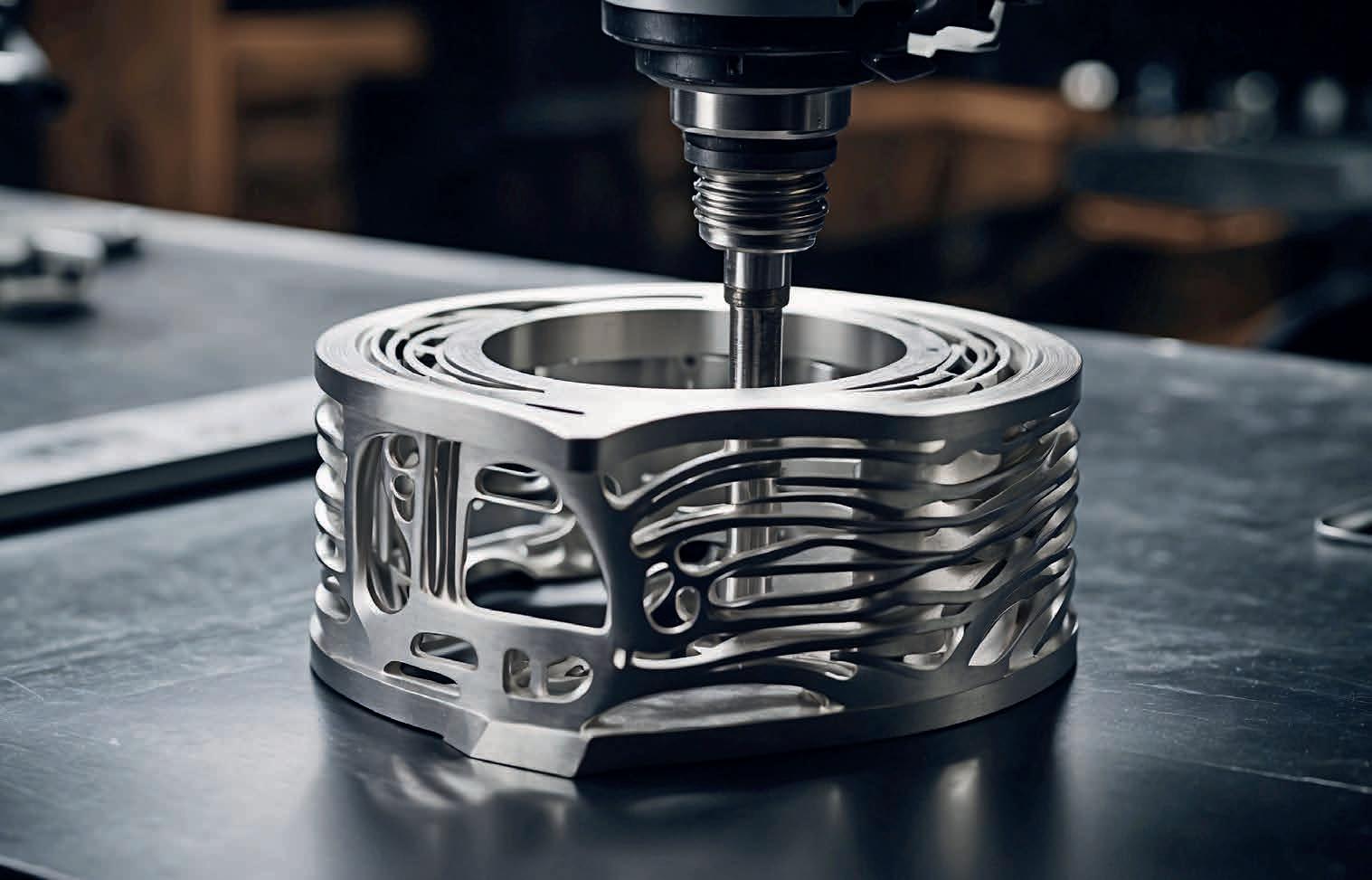
6 Manufacturers’ Monthly April 2024 Image: Inna/Adobe.Stock NEWS EDITOR’S NOTE SYED SHAH – MANAGING EDITOR, MANUFACTURERS’ MONTHLY


WHERE AUKUS MEETS THE QUAD Department of Jobs, Tourism, Science and Innovation GOVERNMENT OF WESTERN AUSTRALIA PARTNERS ORGANISER Defence Security Industry Commerce LEARN MORE WWW.IODS.COM.AU The AUKUS and Quad international partnerships will transform Indian Ocean security, commerce and Australia’s industry capability. Conference and Exhibition Do Business In Great Waters FIND OUT HOW – JOIN THE PROGRAM AT IODS 2024 Contact the IODS Conference and Exhibition team expo@amda.com.au
SIMPLE. STREAMLINED. SECURE.
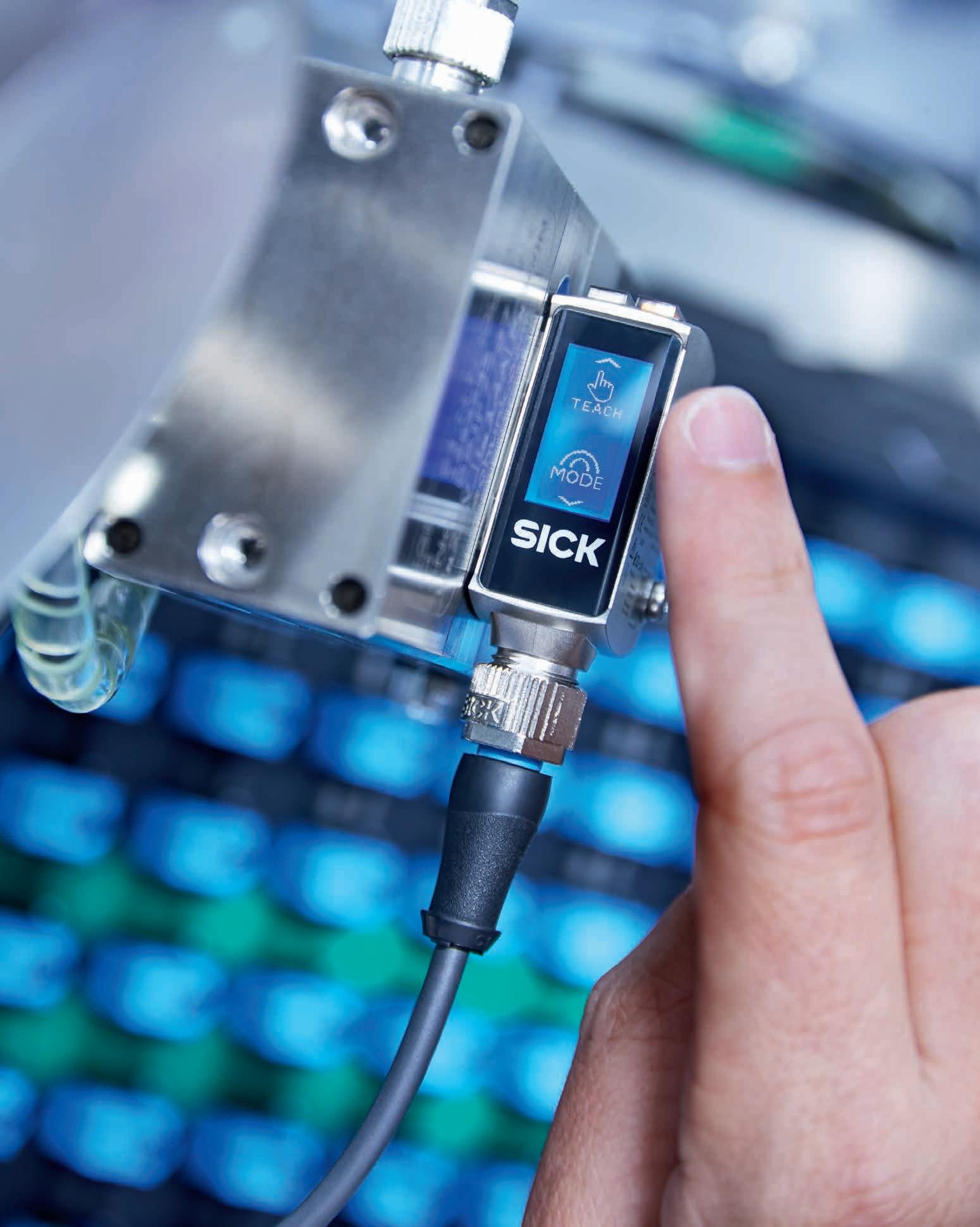
Introducing the world’s first touchscreen photoelectic proximity sensor - the W10 - combining reliable detection with an intuitive operation. Designed around the User, the W10 was optimised for four key application categories. From basic presence detection, to the most optically challenging applications, the W10 provides world-class performance and user experience accompanies you as an expert sensor partner on the way towards highly automated and autonomous mobile machines. The W10 is an all-round solution which offers unparalleled flexibility. A single sensor can be put into stock instead of many different ones with similar properties. For more information, please vist www.sick.com.au/w10 or call 1800 334 802.


Weld Australia urges investment in network of Indigenous welding schools
Weld Australia is urging the Federal Government to invest in a national network of Indigenous Welding Schools to help create real skills and real jobs for Indigenous Australians – and close the gap.

Now is the time to ensure Indigenous Australians have the skills needed to secure meaningful jobs. According to the Productivity Commission’s recently released first review of the National Agreement on Closing the Gap, governments are not adequately delivering on their commitment to the Agreement.
Despite some pockets of good practice, progress in implementing the Agreement’s Priority Reforms has, for the most part, been weak and reflects
tweaks to, or actions overlayed onto, business-asusual approaches. The disparate actions and ad hoc changes have not led to improvements that are noticeable and meaningful for Aboriginal and Torres Strait Islander people.
The Indigenous Welding Schools initiative not only aligns with the national socio-economic targets of the Closing the Gap agreement—enhancing education, employment, and community development for Indigenous Australians—but also offers a tangible
solution to the pressing need for skilled labour in the welding industry.
Over the past fi ve years, Weld Australia has approached every government in a bid to secure funding to create a national network of Indigenous Welding Schools that use the latest augmented reality and advanced welding systems. We have been largely rebuffed by governments of all persuasions.
However, we know that the Albanese Government is genuinely committed to closing the gap for
9 manmonthly.com.au Manufacturers’ Monthly
COMMENT GEOFF CRITTENDEN – CEO, WELD AUSTRALIA
Images: Weld Australia

Indigenous Australians. Weld Australia has written to the Albanese Government, urging it recognise the value and necessity of the Indigenous Welding Schools concept. It represents a strategic investment in the future of industry and the empowerment of Indigenous communities, promising real skills for real jobs.
The Indigenous Welding Schools program would be predominantly run by Indigenous educators and trades people who would mesh the practical demands of the welding trade with a culturally appropriate curriculum, pastoral support, and employment pathways to deliver gate-ready welders to industry. Students would graduate qualified and certified to the internationally recognised welding competency standard ISO 9606.
The model and technology would be identical to that deployed by Weld Australia in its highly successful existing programs: the VET Centre of Excellence in seven Corrections Victoria prisons; and the NSW Advanced Manufacturing Schools Outreach Program, implemented in over 65 schools.
Australia is facing a looming shortage of skilled welders—70,000 additional welders will be needed in the next 10 years. Demand is being driven by Defence, Infrastructure and Resource projects and exacerbated by supply chain issues promoting growth in local companies. The upcoming renewable energy boom will further overheat the market. Welding-specific VET training and employment pathways for Indigenous Australians could help alleviate some of these skills shortages for industry and close the gap for Indigenous Australians.

A national network of Indigenous Welding Schools could help progress three of the 19 national socioeconomic targets outlined in Closing the Gap:
• Students reach their full potential through further education pathways
• Youth are engaged in employment or education
• Strong economic participation and development of people and their communities
A bright trade future
Munster Services Group is a Queensland owned and operated trade services business with over 115 employees and facilities in Slacks Creek, Underwood, Stapylton and Maroochydore. They maintain Queensland’s vital water and wastewater infrastructure, service heavy industry and manufacture water treatment equipment.
As an employer, Munster seeks people with the right attitude and a keen interest in learning and developing, who are reliable and trustworthy. As a result, without seeking to achieve any target, Munster has a diverse workplace, with more than 22 national backgrounds in the team and a First Nations representation of around nine per cent.
Last year, Munster engaged in the First Nations Engineering Skills Set Program with DGT Employment and Training in Meadowbrook, funded by the Local Jobs Program and supported by DATSIP to provide training and work experience to unemployed locals keen to enhance their career opportunities.
Islander man. Pilot wanted to change careers, from a forklift operator to working as a boilermaker or mechanical fitter.
Pilot is undertaking a Certificate III in Engineering through TAFE Queensland and is a first-year mechanical fitting apprentice at Munster. He has proven to be a reliable and hardworking employee, with a bright trade future in one of Queensland’s key skill shortage areas.
According to Pilot, “I chose a career in engineering to gain a different experience and trade in a new line of work. I spent a majority of my working life in the warehousing industry doing picking and packing and forklift high reach driving.”
“I love working hands-on with tools, learning more about the different types of tools used in the industry, and how machinery works. I enjoy the assembly and disassembly of working machinery parts, learning how they work and the importance of their function. It’s also great learning about the different networks and site repairs and maintenance in the field.”
Equipped with our patented multi-position tiller arm the Combi-CS offers safer operation, maximum operator visibility and narrow aisle performance. The tiller can be turned to the left or right, allowing the operator to remain at the side, providing full visibility of the load and forks, while maintaining full steering control, enabling greater awareness of their surroundings which enhances overall safety. Standing to the side of the stacker eliminates the risk of being trapped or crushed while allowing the Combi-CS to operate in very narrow aisles.
Through support of this program, Munster employed John Pilot—a 40-year-old Torres Strait
“The advice I would give other First Nations people considering a career in engineering is that it’s interesting and enjoyable as well as challenging. There’s plenty of ways to expand your qualifications. It’s an industry that is booming and there is plenty of opportunity for growth and moving up in the engineering industry and once your qualified there’s good money to be earned.”
“I encourage anyone who keen to get started in engineering to stick with it. It’s well worth it,” said Pilot.
10 Manufacturers’ Monthly April 2024
John Pilot, a first-year mechanical fitting apprentice at Munster Services Group.

COMBI-CBE
The fully electric multi-directional forklift designed for the safe and efficient handling of long and bulky loads. Suitable for guided aisles, long loads, narrow aisles and palletised goods.
Features include:
• +/- 100mm side shift
• Load sensing steering
• 4-way lever positioning of wheels
• System communication via CAN-BUS
• 2-wheel electric drive
• Powered by AC technology
• Lithium option available



combilift.com
Capacity 2500 kg - 3000 kg Lift Width 1500 mm Engine Type Electric Machinery Type Multi Directional

From technology to products
BluGlass Limited, a Silverwater-based semiconductor manufacturer, recognised potential for growth since its humble beginnings at Macquarie University. Before its official inception, the company pioneered experimental technology, but are now producing its own products using the same revolutionary tech. Manufacturers’ Monthly reports.
BluGlass Limited is an Australian technology company specialising in the development of novel semiconductor materials and devices for the semiconductor industry.
The company specialises in a unique form of semiconductors called compound semiconductors.
BluGlass’ pioneering technology, known as remote plasma chemical vapor deposition (RPCVD), provides numerous advantages to its customers.
This technology enables the production of highquality semiconductor materials, such as gallium nitride (GaN) and indium gallium nitride (InGaN), with significant advantages over traditional deposition methods.
“Most people are very familiar with silicon, the standard semiconductor that companies like Intel and AMD use in computer chips,” said Ian Mann,
chief operations, and technology officer at BluGlass.
“Whereas silicon is a single element semiconductor, compound semiconductors are made by combining two or more elements, and have several advantages over silicon chips, providing greater power, speed, stability, and light.
“The type of semiconductor BluGlass is manufacturing is called gallium nitride or GaN for short; in particular we’re focused on making GaN lasers.”
History
BluGlass Limited was founded in 2006 as a spin-off from the III-V semiconductor research group at Macquarie University in Sydney.
The company was established to commercialise ground-breaking research in the field of
semiconductor materials, particularly focusing on the development of innovative deposition technology, RPCVD, a manufacturing reactor that grows semiconductor materials at atomic scale on specialised wafers.
This technology was designed for the manufacture of semiconductor materials, particularly gallium nitride (GaN), which is commonly used in lightemitting diodes (LEDs) and other electronic devices.
By 2007, its new state-of-the-art semiconductor deposition and demonstration facility located in Silverwater was officially inaugurated.
Shortly after Mann joined BluGlass in 2010, the company underwent a significant pivot from focusing on equipment manufacturing to optimising its proprietary RPCVD technology.
By leveraging its innovative technology, BluGlass
12 Manufacturers’ Monthly April 2024 MANUFACTURER FOCUS
Images: BluGlass

transformed into a technology-driven company.
By 2015, the company had conducted validation studies and demonstrations to showcase the effectiveness of its RPCVD technology for GaN deposition.
BluGlass also expanded its intellectual property portfolio during this period, securing patents related to RPCVD technology and semiconductor device manufacturing processes.
“We started out as a technology company, focused on selling our equipment and licensing our unique IP as our go-to-market approach for the first half of my tenure at BluGlass,” Mann said.
“As we continued to build our technology capability, both at the equipment and device level, demonstrating LEDs, lasers, microLEDs and power and electronics; while helping customers solve complex challenges, we realised that we had a unique competitive advantage with our equipment and foundry services business.”
“We realised we could capture greater market share and create more shareholder and economic value by pivoting our model and using these capabilities to our advantage, to make devices and provide them direct to customers.”
Manufacturing capability
Since 2019, BluGlass’ primary manufacturing focus has been developing and commercialising their visible laser portfolio.
In 2022, the Company acquired a full-suite laser fabrication facility in Silicon Valley to bring its downstream manufacturing supply chain in-house. BluGlass’ semiconductor manufacturing involves multiple-steps to turn the GaN wafers into laser devices ready for customer integration, which relies on facilities located in New South Wales, California, and New Hampshire.
As Mann explained, BluGlass “grows” its semiconductor materials using large and complex machines located in the company’s Silverwater facility in Western Sydney.
“These deposition systems physically grow the semiconductor materials in precise atomic structures to create the building blocks for the electronic circuits on the wafers,” he said.
“We specialise in designing specific material stacks or layers crucial for producing high-quality lasers.”
Once the materials have been produced, the wafers are then sent to its facilities in California for the microfabrication process.
“We prepare and polish the wafers, add metal contacts at the chip level for electrical connections, and cut the wafers into individual chips or bars (multiple chips) to transform those materials into lasers.”
When the lasers have been manufactured, they are then sent to New Hampshire to be packaged and reliability tested.
“Now, packaging is not putting it in a box. Highpower diode lasers require sophisticated packaging designs to protect the device in its operating environment, while managing the heat dissipated during use through specialist sealed containments and thermal heatsinks, while also preparing the device for customer integration,” said Mann.
The Company is now one of only a handful of manufacturers globally with this full-suite capability to manufacture this critical enabling technology, underpinning global megatrends.
The industry
BluGlass has established two crucial customer relationships. One notable partnership is with Applied Energetics, a company specialising in ultrashort pulse laser systems.
“They supply advanced laser systems for defence, aviation, and national security applications and are a key commercial partner,” said Mann.
Additionally, BluGlass is engaged in a collaboration and customer relationship within the US$2B US Microelectronics Commons initiative, stemming from the CHIPS Act in the US.
The initiative, supported by the US Department of Defence (DoD), focuses on advancing technology areas, with BluGlass specifically being supported by
the “lab-to-fab” pathway.
Lab-to-fab aims to facilitate a pathway from laboratory development to commercial manufacturing for semiconductor projects, helping manufacturers overcome the challenges typically encountered during this transition phase.
“Because we have a US presence, we were eligible for the commercial lab-to-fab pathway,” said Mann.
“It’s a multi-year programme, of which we’ve secured the first-year contract. As an approved commercial manufacturing partner in the Microelectronics Commons, in addition to the core program, we are working on DoD’s call for projects now. That is aimed at advancing next generation semiconductors for quantum intelligence and computing, and artificial intelligence.”
“That’s a major undertaking. Both the core development, and if we are successful in securing additional projects, this work will both accelerate and fund our roadmap and, more importantly, embed us into an ecosystem of potential customers and partners.”
The workforce
BluGlass’ workforce is currently divided between the US and Australia; with the majority now employed in the US.
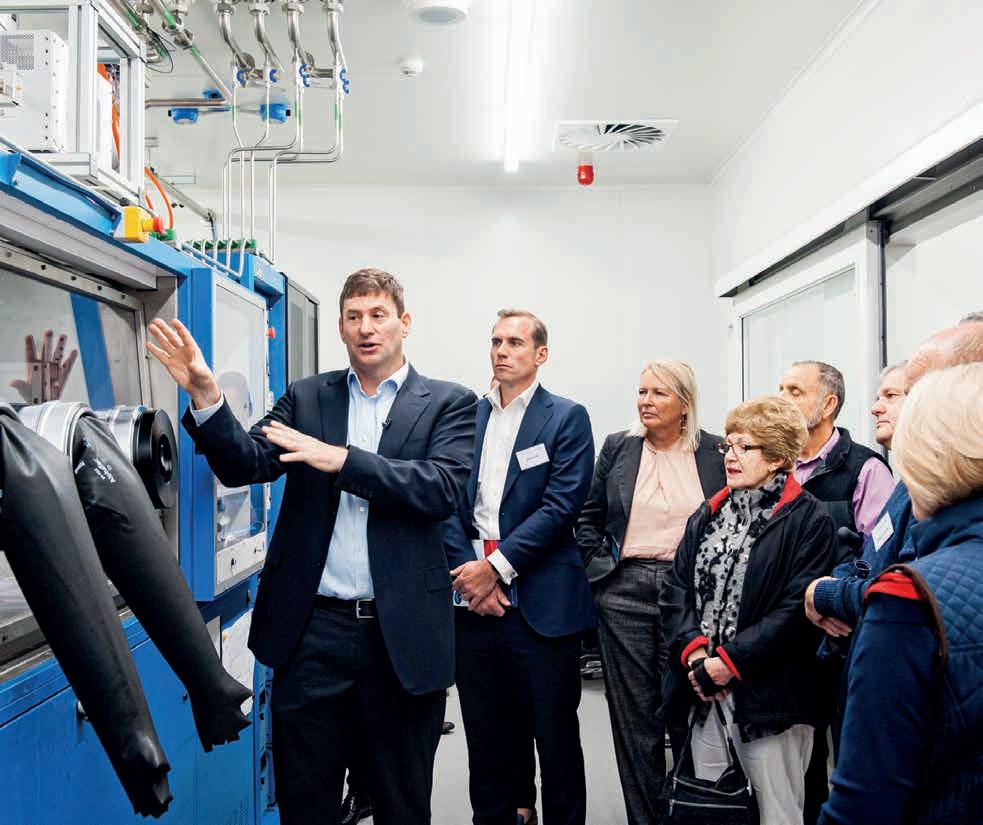
13 manmonthly.com.au Manufacturers’ Monthly
Below, Ian Mann leads an open day event at BluGlass’ facility in Silverwater.
MANUFACTURER FOCUS

As the company has grown, BluGlass has consistently expanded its US workforce.
“Our industry leading team in Australia is well established. Since the fab acquisition, we have been adding highly skilled expert staff in the US. We are very fortunate with the depth of talent now available to us in Silicon Valley, which simply does not exist domestically right now,” said Mann.
“Because of the existing capability in Australia, and now the US, we have sufficient capacity installed to fulfill the next several years of our roadmap with the right staff, and equipment.”
“We figured out a good way to collaborate with our overseas colleagues in New Hampshire and California, which is enabling us to embrace the best of all worlds.”
Hiring top talent has been challenging in both the US and Australia.
Due to the highly competitive market in the US, BluGlass is compelled to face industry giants who are hiring specialised workers at an extreme rate.
“There are a lot of people who’ve got good experience in the US and have worked at other companies. But they’re also in demand,” Mann said.
“With the prolific nature of companies like Apple, Google, and Facebook when it comes to hiring there’s a lot of competition out there for specialty skills.”
“The nice thing there is that those potential employees don’t need a lot of training, they most likely already have relevant experience, and they can hit the ground running.”
In Australia, the challenge is semiconductor hardware engineers are hard to find.
“We’re using a lot of sophisticated equipment for semiconductor manufacturing requiring strong skills in engineering, process scientists, material scientists, and physicists,” said Mann.
“But sometimes to get people who know the ins and outs of this high-tech vacuum equipment, they often need to be sourced from overseas, as there doesn’t tend to be a lot of that existing hardware engineering talent within Australia.”
“We’ve had success hiring out of the automotive industry here, and upskilling in our equipment, but it then takes time to perfect the skills,” Mann explained.
To ensure that its workforce remains strong, BluGlass has instilled a strong culture of loyalty within the company.
“The unique aspect of our hiring process in Australia is that we really build in strong loyalty, which is demonstrated by low staff-turn over,” said Mann.
BluGlass is also actively involved with multiple leading universities, offering internships, and collaborating on grants.
“That’s been a very successful approach for us from a number of schools,” said Mann.
“Given that we’ve been around for a while, we know
14 Manufacturers’ Monthly April 2024
RPCVD is a manufacturing reactor that cultivates semiconductor materials on specialised wafers at the atomic scale.
a lot of the universities, and we’ve often offered industry linkage grants, or had activity with them.”
“It’s a great way to meet some of the top upcoming talent and you get them involved either through an internship or through a collaboration, to create more skills and hands-on know-how, right here onshore.”
BluGlass is aiming to help the growth of semiconductor industry in Australia, which could entice skilled workers from overseas.
“We would love to see the semiconductor industry here in Australia grow not just for the benefit of BluGlass, but for the whole industry,” said Mann.
Visions for the future
BluGlass’ existing and next-gen laser products heavily focus on ultraviolet (UV) laser technology.
BluGlass recognises the potential for UV in diverse applications such as sterilisation, water purification, and quantum technologies.
“These are very short wavelengths, they can be used in a lot of exciting applications, such as quantum sensing applications for aviation and defence, quantum computing including for AI or utilised in advanced sterilisation and bio-medical applications,” Mann said.
Despite the challenges in manufacturing UV lasers, BluGlass also aims to extend its existing capabilities within visible wavelengths, ranging from violet to blue, through to green.
for innovative projects, willing to tackle difficult technological advancements.
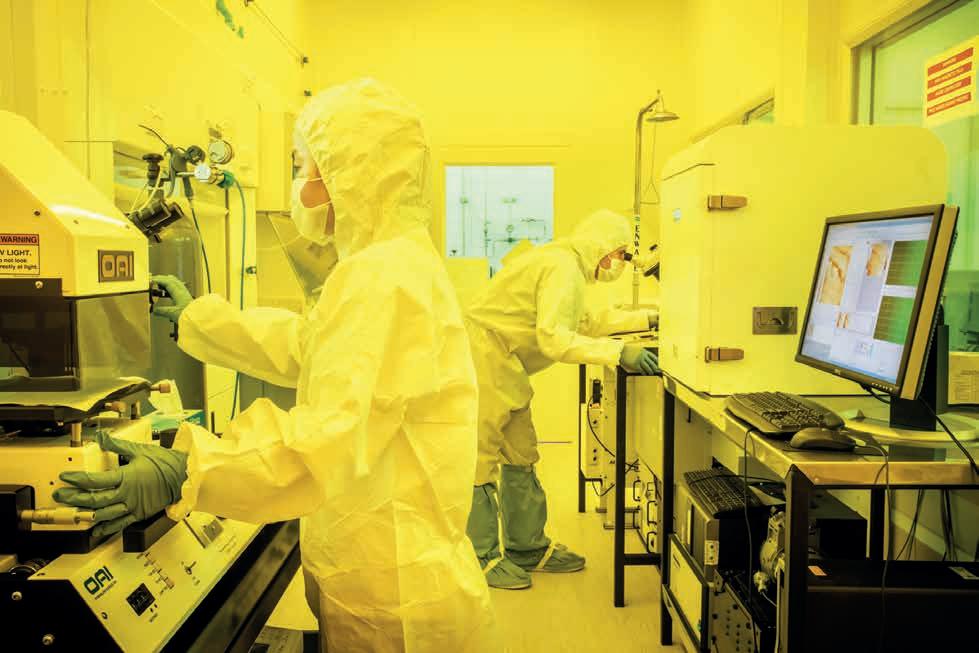

“Things like water purification, that’s a rich area for innovation, but making UV lasers is very challenging,” said Mann.
“Once we’ve established our footprint in visible lasers, we will then start extending our development into these other wavelength areas.”
While this strategy may require more time and innovation, BluGlass is confident in its ability to explore new products and applications with its experienced and innovative team.
“That’s our vision and we do think that we can
“We’re willing to do some of the harder technology development, at the same time, extracting a higher profit margin for that.”
“Additionally, our lasers will potentially be designedin next-generation technologies that supersede existing markets, while opening new ones.”
Mann believes that BluGlass’ commercialisation phase is coming to fruition after collaborating with DoD and with other industry giants including General Electric, Coherent and Wolfspeed as part of its Hub in the Microelectronics Commons

Renowned for their expertise in visible lasers, BluGlass is expanding its focus to encompass additional wavelengths.
15 manmonthly.com.au Manufacturers’ Monthly
To maintain a robust workforce, BluGlass has fostered a culture of loyalty among its employees.
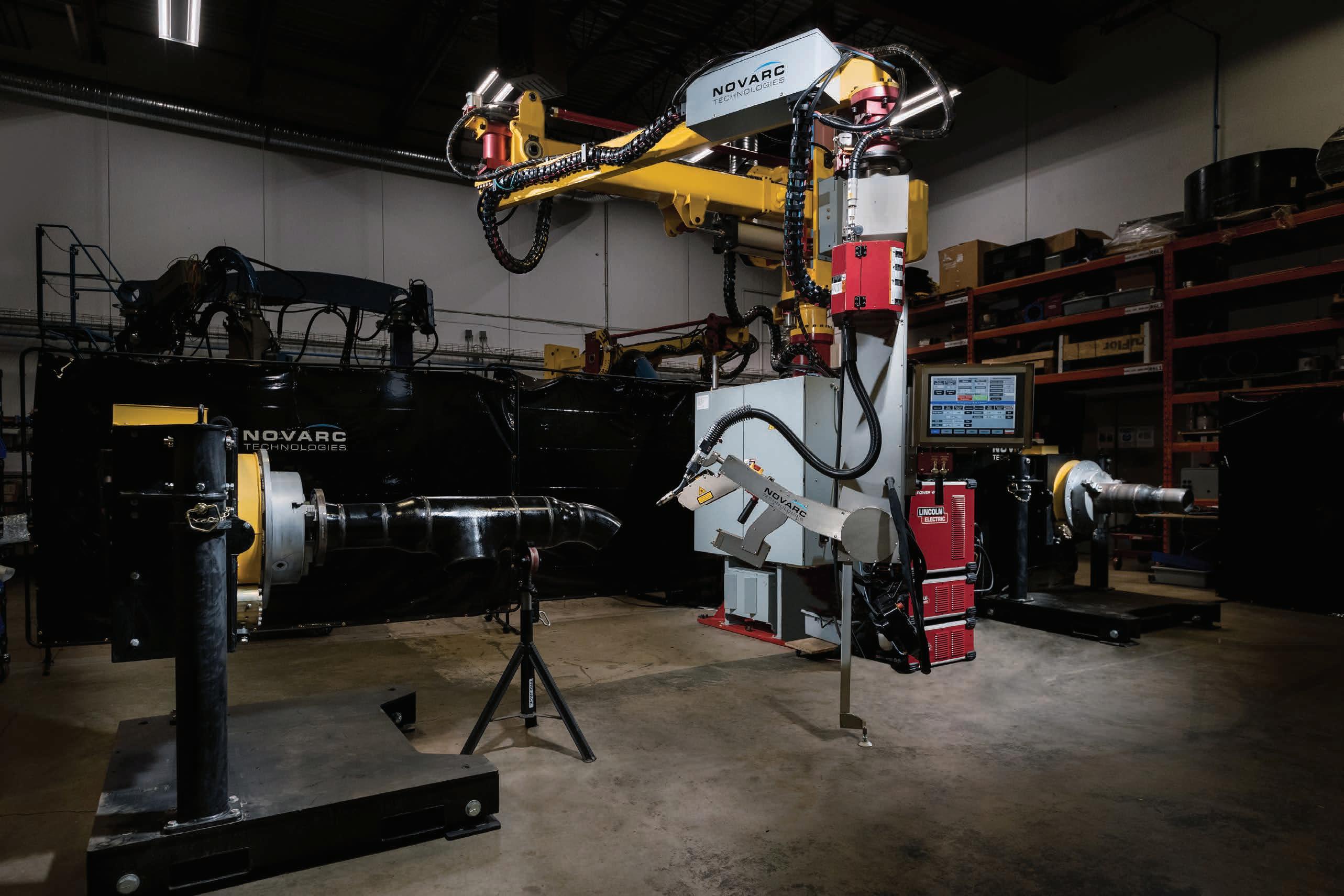
the ONLY Autonomous Spool Welding Robot
With


Space Machines has Australia’s largest satellite ready for launch
Local space company Space Machines has announced the completion of Optimus, the country’s largest private satellite to date. This pioneering Orbital Servicing Vehicle is set to launch with SpaceX next month.
The completion of Optimus marks a major milestone for Australia’s sovereign space capabilities and reinforces Space Machines’ commitment to developing innovative space solutions that are built on local soil.
As the first Australian commercial satellite capable of providing existing space infrastructure and satellites with life-extension services,
inspections and assistance on-orbit, Optimus heralds the beginning of a new era in space sustainability.
Space Machines chief executive officer, Rajat Kulshrestha said “Together, we are paving the way to provide innovative services that extend satellite lifetimes, reduce space debris, and sustainably scale space activities for the benefit of all.” Optimus carries groundbreaking technology payloads from partners and suppliers, including Advanced Navigation, which has developed a revolutionary Digital Fiber Optic Gyroscope (DFOG) Inertial Navigation System.
Global provider of on-orbit refuelling services, Orbit Fab, is supplying critical position and orientation data through its fiducial markers to ensure safe and reliable on-orbit operation.
Space Machines’ Optimus will launch as part of SpaceX’s Transporter-10 mission no earlier than March 2024 from Vandenberg Space Force Base in California.
Space Machines Company also appreciates the ongoing support from government agencies including Investment NSW, the Australian Space Agency, Defence Space Command, and the Government of South Australia.
17 manmonthly.com.au Manufacturers’ Monthly Space Machines aims to develop a next-generation fleet of in-space infrastructure servicing vehicles. Image: Andrei Armiagov/stock.adobe.com NEWS
Vanadium battery manufacturing agreement signed for Townsville
Vecco Group, Sumitomo Electric and Idemitsu have signed a collaboration agreement to market, sell and deliver the batteries, from North Queensland.
Vanadium flow batteries are set to be manufactured out of North Queensland, under a new agreement between three major companies.
Idemitsu Australia, Sumitomo Electric Industries and Vecco Group (the group) have signed a Collaboration Agreement to build a complete manufacturing supply chain, from mining to energy storage.
Vanadium flow batteries are set to be a key part of Australias energy storage mix with demand rapidly increasing around the globe.
Queensland Premier Steven Miles said, “Today’s announcement shows how our 75 per cent emissions reduction target by 2035 secures investment in new blue-collar clean economy jobs across our regions.” Under the non-exclusive agreement, Idemitsu
Vecco
plans to market, sell and deliver vanadium flow batteries to Australian customers using Sumitomo Electric hardware and Vecco’s electrolyte made from vanadium mined in Queensland’s northwest minerals province.
Vecco Group will mine and refine high purity vanadium at their Julia Creek mine and manufacture battery electrolyte in Townsville. Detailed design for a commercial production facility is underway.
To cater for the growth expected under this new agreement, Vecco has now secured a 3.2-hectare site at Cleveland Bay Industrial Park (CBIP), in the Townsville State Development Area, for its commercial production facility.
Resources minister and Townsville MP Scott Stewart said, “There is potentially $500 billion dollars of critical minerals in the Northwest Minerals Province and vanadium is one of the commodities Queensland can supply to the world.”
Vecco Group received support from the Industry Partnership Program to establish Australia’s first vanadium electrolyte manufacturing facility which is currently operational in Townsville.
Vecco Group managing director Tom Northcott said, “Over 7.4GWh of vanadium flow battery projects globally are currently under construction or have been announced in the last 12 months.”
“The decision for Idemitsu to market and deploy vanadium flow batteries using Sumitomo and Vecco products acknowledges the scale of the opportunity,” said Northcott.
An end-to-end vanadium flow battery manufacturing supply chain means Queenslanders will be making batteries in Queensland from critical minerals mined in Queensland. That means more blue-collar mining and manufacturing jobs in North Queensland providing the batteries needed for renewable energy.

18 Manufacturers’ Monthly April 2024
NEWS
Image: IM Imagery/stock.adobe.com
has secured a 3.2-hectare site at Cleveland Bay Industrial Park in Townsville to meet the expected growth from the new agreement.
$11.1bn investment to deliver Navy’s enhanced lethality surface combatant fleet
The Federal Government’s blueprint for the Royal Australian Navy’s enhanced lethality surface combatant fleet will deliver direct investment to grow a capable, resilient, and competitive sovereign defence industrial base and support Australian jobs.
The Government has committed to increase Defence’s funding in the 2024-25 Federal Budget by $11.1 billion over the next decade to ensure the enhanced lethality surface combatant fleet is funded.
Australian shipbuilders and industry will be at the centre of delivering this future fleet. The Federal Government is providing a clear pipeline of work and setting the conditions for job creation, technology investment, export opportunities, supply chain resilience, infrastructure enhancement and economic prosperity.
Over the next ten years, this investment will support more than 3,700 direct jobs and deliver the critical infrastructure required at the Osborne shipyard in South Australia and Henderson shipbuilding complex in Western Australia.
Deputy prime minister, the hon Richard Marles MP said “After inheriting the oldest surface fleet Navy has operated in its history, this blueprint will see Navy equipped with a major surface combatant fleet

over twice as large as planned when we came to government, with more surface combatants in the water sooner.”
Combined with more than 4,000 estimated jobs created to build the new Submarine Construction Yard in South Australia and the more than 4,000 direct jobs to build conventionally armed, nuclearpowered submarines in Australia, Osborne will be at the epicentre of a naval shipbuilding jobs revolution in this country.
“The delivery of an enhanced lethality surface combatant fleet and sovereign shipbuilding industry will help secure Australia’s economic prosperity and trade, and help keep Australians safe,” said Marles.
Government invests $3.4m for Defence Industry Manufacturing grants
The Federal Government is investing $3.4m in innovative Australian businesses to support the delivery of cutting-edge defence capabilities while creating highly skilled jobs and boosting local manufacturing.
The latest round of the Defence Global Competitiveness and Sovereign Industrial Capability Priority programs will provide 50 per cent matching grants to 10 businesses, creating more than 50 jobs and helping to drive exports.
Grant recipients include a New South Wales company developing state-of-the-art counter-drone technology, a South Australian producer of composite structures for guided munitions and hypersonic vehicles. It also includes a Queensland business that manufactures complex components for use in precision guided munitions and hypersonic vehicles.
This vital assistance adds to more than $100m already awarded to over 230 Australian businesses under the two grant programs which support delivery of capabilities prioritised in the Government’s
response to the Defence Strategic Review. Some of the latest recipients are:
• Aerobond (SA) receiving $849,876 to acquire and commission a 5-axis computerised numerical control machining centre, composite filament winding machine and related manufacturing capabilities for production and integration of composite structures and electronics in support of guided munitions, hypersonics and integrated defence systems.
• U-Neek Bending Co (VIC) receiving $631,833 to acquire and commission a Trumpf TruLaser Weld 5000 system for welding complex metal parts used in aerospace, land combat vehicles and munitions.
• Advanced Navigation (NSW) receiving $278,756 to acquire a wire bonder and associated equipment to establish a photonic chip assembly and characterisation capability, for use in inertial navigation and navigation Doppler Light Detection and Ranging (LiDAR) systems.
• Protonautics (QLD) receiving $245,267 to acquire
Consolidation of the Henderson precinct is currently underway, as recommended by the Defence Strategic Review. Successful and timely consolidation will enable eight new general-purpose frigates to be built at the Henderson precinct and will also enable a pathway to build six new Large Optionally Crewed Surface Vessels in Western Australia.
Minister for defence industry, the hon Pat Conroy MP said, “The innovation and ingenuity of our dynamic defence industry is critical to the Albanese Government’s plan to deliver four times as many warships in the next 10 years compared to what had been planned by the previous government.”

and commission a computerised numerical control multi-tasking turning centre, measurement probes and non-destructive test capabilities to support the manufacturing of components for precision guided munitions and hypersonic vehicles.
Minister for defence industry, Pat Conroy stated, “The Government is committed to making sure Australian Defence Force personnel are equipped with the capabilities they need to keep Australians safe and protect our national interests.
19 manmonthly.com.au Manufacturers’ Monthly
Rafael Ben-Ari/stock.adobe.com
Image:
The Navy’s future surface combatant fleet will feature upgraded Hobart class air warfare destroyers, Hunter class frigates, new general purpose frigates, and Large Optionally Crewed Surface Vessels.
Image: Ryan/stock.adobe.com
These programs prioritise capabilities outlined in the Government’s response to the Defence Strategic Review.
Global pharmaceutical manufacturer arriving in South Australia
Global pharmaceutical company, Noumed, has made groundbreaking construction towards its $100 million pharmaceutical manufacturing facility at Salisbury, creating 250 construction jobs and 180 ongoing jobs upon completion.
Noumed Pharmaceutical, part of the United Kingdom’s Noumed Life Sciences, is building its first Australia manufacturing plant in Salisbury after receiving $20 million to support construction under the previous Federal Government’s Modern Manufacturing Initiative.
An integrated generics pharmaceutical company, the local facility will produce onshore, 40 million units of tablets, liquids and creams a year, which will replace products currently manufacturing in the United Kingdom.
The 43,000m² facility, which is two and a half times the size of Adelaide Oval, will enhance Australia’s sovereign supply into the pharmacy network and will be one of Australia’s largest drug manufacturing investments in recent years.
Noumed is located at the Nexus North Industrial Estate, next to Mayne Pharma and close to other medical manufacturers including ophthalmic equipment makers Ellex Medical.

One million AI introduction scholarships now available to Australians
Artificial intelligence scholarships are now on offer to one million Australians, in a bid to increase the nation’s literacy of a technology estimated to be worth $4 trillion to the economy by the early 2030s.
The free ‘Introduction to Artificial Intelligence’ microskill course is provided by the National AI Centre (NAIC), coordinated by Australia’s national science agency, CSIRO, and the Institute of Applied Technology Digital (IATD).
The course will provide a non-technical introduction to AI fundamentals and is designed for people at the beginning their AI literacy journey.
With many small to medium enterprises (SMEs) grappling with the challenge of adopting AI the course is an opportunity for business owners to deepen their understanding.
NAIC director Stela Solar said, “SMEs make up over 98 per cent of Australia’s economy, and ‘Introduction

to AI’ is their opportunity to learn how they can use this revolutionary technology to enhance their operations, services, and market competitiveness,” Ms Solar said.
Minister for industry and science Hon Ed Husic said, “This is practical and pragmatic support for small businesses, who don’t have the same access to tech know-how as big business, but have just as big a need to improve productivity.”
This makes it ideal for workers seeking to upskill, individuals starting their career in AI, and small to medium business owners.
Council of Small Business Organisations Australia (COSBOA) chief executive officer Luke Achterstraat said, “This microskill course will help build confidence and competency for small businesses as they navigate the AI landscape.”
Director of IATD operations Helen Fremlin said, “No programming or computer science background is required for students to enrol, and the virtual nature of this course facilitates an easier path for Australians to upskill in AI, whenever and wherever they choose.”
20 Manufacturers’ Monthly April 2024 NEWS
Image: Shuo/stock.adobe.com
Image: IM Imagery/stock.adobe.com
Students will receive a certificate of completion upon finishing the course.
The local facility will annually manufacture 40 million units of tablets, liquids, and creams onshore.

NSW Government grants $275m for Net Zero Manufacturing Initiative
The NSW Government has announced $275 million in grants under the Net Zero Manufacturing Initiative, to secure NSW as the place to develop and manufacture clean technology and create new jobs in the process.
The Net Zero Manufacturing Initiative will support workers, small businesses, manufacturers, and innovators to take advantage of the transformation of our energy grid.
NSW Premier Chris Minns, said, “These grants will bolster local manufacturing in the renewables and clean-technology industries, ultimately delivering more local, secure jobs.”
The move to net zero will also transform our economy, and these grants will ensure NSW manufacturing is part of this revolution.
Minister for climate change and energy, Penny Sharpe said, “These grants are all about ensuring NSW manufacturing is part of this revolution. They will lead to new secure, long-term jobs that are good for the planet but also build wealth in local communities and give NSW security and sovereignty of the renewable energy supply chain.”
The initiative will deliver more local, secure jobs
across the state, and support the diversification of our regional economies.
This investment areas include future energy systems and storage, transportation, built environment, biomanufacturing, power-fuels including hydrogen and agricultural technologies.
The Net Zero Manufacturing Initiative will offer the grants to three markets.
Renewable Manufacturing: increasing capacity to make the components for renewable energy projects, which will alleviate supply chain constraints and increase local content capability.
Such as projects that include constructing a brand-new facility for the manufacture of solar cells, or supply chain parts for renewable energy transmission.
Clean Technology Innovation: helping businesses get scalable low-emission technologies, marketready.
For example, prototypes of next generation residential batteries, or new laboratory equipment that can test a material’s ability to store hydrogen atoms.
Low Carbon Product Manufacturing: establishing
industrial facilities and manufacturing capabilities that can take advantage of investment in new and emerging low carbon industries.
Such as building a new facility for the manufacture of low-carbon laminate timber or implementing a new production line within an existing biomass facility for manufacturing biodiesel.
The Net Zero Manufacturing Initiative will focus on already lab-proven technologies and the manufacturing of market-ready products that are ready to be scaled up and rolled out across NSW.
This will support NSW’s 5 Renewable Energy Zones and hydrogen hubs, giving them access to more materials produced in NSW.
Minister for domestic manufacturing and government procurement, Courtney Houssos said, “For every one job in manufacturing, three-and-ahalf other jobs are sustained in the supply chain. We want those secure, well-paid manufacturing jobs to be in NSW.”
The investment areas are aligned to the opportunity areas identified through the NSW Decarbonisation Innovation 2023 Study, released by the Office of Chief Scientist and Engineer.
21 manmonthly.com.au Manufacturers’ Monthly
Image: Phattana/stock.adobe.com
The initiative will create additional secure jobs locally and aid in diversifying regional economies.

Hysata welcomes UN climate official to Port Kembla electrolyser facility
Australian electrolyser company Hysata hosted executive secretary for the United Nations executive secretary of the United Nations Framework Convention on Climate Change (UNFCCC) Simon Stiell last Friday in Port Kembla.
Minister for climate change and energy the Hon Chris Bowen MP and member for Cunningham Alison Byres MP joined Mr Stiell for a tour of Hysata’s electrolyser manufacturing facility during his first official visit to Australia.
Hysata chief executive officer Paul Barrett said, “It was a huge honour for Hysata to welcome Mr Stiell, the United Nations’ leading authority on climate change to showcase our high efficiency electrolyser and manufacturing capability.”
“Mr Stiell had some incredibly insightful comments about the urgency of global climate action, and the importance of government, industry and academia working together to solve challenges,” said Barrent.
“Mr Stiell recognises that green hydrogen has a vital role to play in the deep decarbonisation of the hard-to-abate sectors such as chemical and steel manufacturing, high-grade industrial heat and heavy transportation.”
Hysata is an Australian electrolyser company headquartered in Wollongong that is developing a completely new type of electrolyser, featuring the world’s most efficient electrolysis cell.
“We are incredibly humbled the Minister chose
Hysata as an example of Australian ingenuity for Mr Stiell’s first official visit to Australia and being able to showcase the potential of the Illawarra region in the transition to net zero,” said Barrent.
Electricity makes up most of the cost of green hydrogen and therefore, the most efficient electrolyser will deliver the lowest cost hydrogen.
“Mr Stiell recognises that green hydrogen has a vital role to play in the deep decarbonisation of the hard-to-abate sectors such as chemical and steel manufacturing, high-grade industrial heat and heavy transportation,” said Barrent.
Backed by leading global investors, Hysata is moving rapidly towards manufacturing at the multigigawatt scale needed to address climate change.
22 Manufacturers’ Monthly April 2024 NEWS
peter/stock.adobe.com
Image:
According to ARENA, the Port Kembla facility has the potential to transform the economics of renewable hydrogen production.
Victoria revealed as Australia’s $1bn fashion manufacturing capital
Victoria has been named the nation’s biggest clothing manufacturing capital with the sector valued at almost $1 billion, according to Australian Fashion council.
With its eco-system of fibre, manufacturing, retail, and wholesale, alongside repair and second-hand retail, Victoria has the most complete clothing supply chain in Australia.
The Australian Fashion Council (AFC) in partnership with Epson Australia, commissioned RMIT to quantify the true value of the Victorian textile, clothing & footwear (TCF) manufacturing sector.
AFC have announced, as part of a full report due to be released in April, that Victoria’s TCF manufacturing industry is valued at $960 million in economic value and employs 10,300 people.
NSW is the second highest state, employing 9,000 people.
Chair of the AFC Marianne Perkovic said, “Victoria can be a global leader in advanced, sustainable manufacturing, while boosting jobs and developing skills in an industry that generates a huge $960 million.”
Victoria is best positioned to lead Australia’s

transition into a circular and sustainable economy due to its most complete clothing ecosystem, including fibre, manufacturing, retail, wholesale, repair, and second-hand retail.
This initial research shows employment, exports, imports, and revenue in the TCF manufacturing sector have stabilised.
A recommendation from the report is to optimise microfactories. Microfactory technology has allowed small, on-demand and quick-to-market merchandise offerings to inject newfound vitality
CSIRO’s flexible solar cells launched into space aboard private satellite
State-of-the-art printed flexible solar cell technology developed by Australia’s national science agency, CSIRO, was successfully launched into space today aboard Australia’s largest private satellite, Optimus-1, on Space X’s Transporter- 10 mission.
Space program director of CSIRO, Dr Kimberley Clayfield said, “CSIRO’s printed flexible solar cells could provide a reliable, lightweight energy solution for future space operations and exploration.”
CSIRO is exploring the potential of printed flexible solar cells as a reliable energy source for future space endeavours, in collaboration with Australian space transportation provider, Space Machines Company.
“If the space flight test reveals similar performance as we’ve shown in the lab, this technology offers significant advantages over traditional silicon-based solar,” said Clayfield.
Eight mini-modules of CSIROs Australian-made printed flexible solar cells were attached to the
surface of Space Machine Company’s Optimus-1 satellite.
CSIRO renewable energy systems group leader Dr Anthony Chesman said, “Our perovskite cells have been achieving incredible outcomes on earth and we’re excited that they’ll soon be showcasing their potential in space.”
The completion of Optimus is a milestone for local Space Machines Company.
Space Machines Company chief executive officer Rajat Kulshrestha said, “Through perseverance and teamwork, our engineers and scientists, alongside partners like CSIRO, have created something truly ground-breaking.”
This launch is a great opportunity for Australian technology to contribute to global space exploration.
“Based on our research we expect our printed flexible solar cells will stand up to the effects of cosmic electron and gamma radiation which can compromise the performance and integrity of traditional solar cells,” said Chesman.
into the industry.
Managing director of Epson Australia Craig Heckenberg said, “By embracing the latest digital printing technology with localised, demand-driven manufacturing, these nimble entities signifi cantly reduce waste and enhance effi ciency, aligning perfectly with the principles of the circular economy while delivering speed to market.”
The initial report findings are available from www.ausfashioncouncil.com and the full report will be released in April 2024.

“We are also confident these cells will outperform traditional cells in cases where sunlight hits them at non-optimal angles.
The printed flexible solar cell technology was successfully launched into space on 5 March 2024 aboard Australia’s largest private satellite, Optimus-1.
23 manmonthly.com.au Manufacturers’ Monthly
Image: zhengzaishanchu/stock.adobe.com
Image: CSIRO
According to the Australian Fashion Council, Victoria has the highest number of individuals employed in fashion manufacturing compared to any other state.
CSIRO’s recent paper in ACS Applied Energy Materials explores the potential of printed flexible solar cells in space.
Australia’s biggest renewable power deal signed by industry leader
Rio Tinto has signed Australia’s largest renewable power purchase agreement (PPA) to date to supply its Gladstone operations in Queensland, agreeing to buy most of the electricity from Windlab’s planned 1.4GW Bungaban wind energy project.
The agreement, which of follows the announcement last month of PPA for the Upper Calliope solar farm in Queensland, will make Rio Tinto the biggest industrial buyer of renewable power in Australia and is another major step in the work to repower the company’s Gladstone production assets of Boyne aluminium smelter, Yarwun alumina refinery and Queensland alumina refinery.
Under the new PPA with Windlab, Rio Tinto will buy 80 per cent of all power generated from Bungaban wind energy project over 25 years. The project which, is currently in early development, will be built and operated by Windlab at a site in Queensland about 40 kilometres from the town of Wandoan, and 290 kilometres south-west of Gladstone, subject to development and grid connection approvals.
The remaining 20 per cent of the project’s generated electricity will supply Australia’s
National Electricity Market, delivering clean electricity to homes and businesses.
Rio Tinto chief executive Jakob Stausholm said, “This agreement with Windlab builds on our momentum in our work to repower our Gladstone operations and provide a sustainable future for heavy industry in Central Queensland.”
The PPA is the second renewable power deal signed for Rio Tinto’s Gladstone operations, after the recent agreement signed with European Energy to drive development of the 1.1GW Upper Calliope solar farm.
“Competitive capacity, firming and transmission, are critical to developing a modern energy system that can ensure more large-scale renewals development in Queensland and help guarantee the future of Australian industry,” said Stausholm.
Once developed, the combined 2.2GW of renewable PPAs with Windlab and European Energy have the potential to lower carbon emissions by about 5 million tonnes per year and could generate the equivalent of 10 per cent of Queensland’s current power demand.
Windlab chief executive officer John Martin said, “This agreement highlights the importance
of large-scale renewable energy projects in shoring up Queensland’s powerhouse traditional industries, particularly minerals and advanced processing, which employ thousands of people in regional communities across the state and have a key role to play in our nation’s low-carbon future.”
The Bungaban PPA will bring more renewable power into one of Australia’s most important industrial hubs and marks another step towards Rio Tinto’s climate goal of having its global scope 1 and 2 carbon emission this decade. If combined with more renewable power and suitable firming, transmission, and industrial policy, the Bungaban and Upper Calliope PPAs could also provide the core solution to repower Rio Tinto’s three Gladstone production assets.
“Bungaban is a key transition opportunity that will create up to 600 new Queensland construction jobs and inject around $500 million into regional economy through local economy, supply and contacting,” said Martin.
Once approved, construction of the Bungaban project is targeted to start in late 2024 and is expected to produce electricity by 2029, employ up to 600 people during construction and support up to 30 permanent jobs when operating.

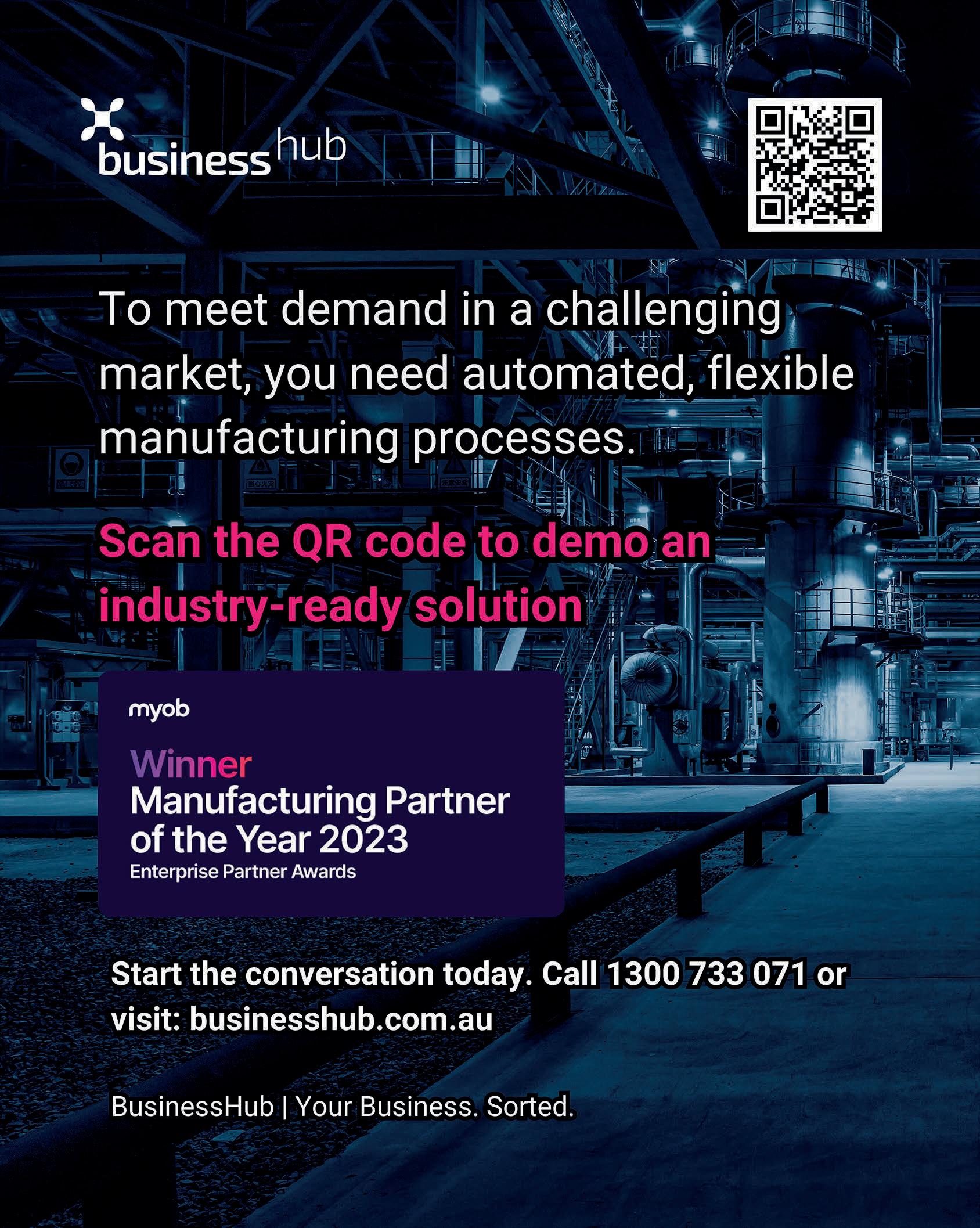
24 Manufacturers’ Monthly April 2024 NEWS
Image: Tobias Arhelger/stock.adobe.com
Under the new PPA with Windlab, Rio Tinto has committed to purchasing 80 per cent of the total power generated from the Bungaban wind energy project over the next 25 years.


Australian Innovation goes global
Innovation and quality have powered Australian manufacturer Ozroll from Dry Creek in South Australia to markets across Europe. With an office in Germany and customers in Poland, the Czech Republic, Switzerland, Austria, France, and Spain, Ozroll’s story highlights Australian manufacturing competence and a relentless pursuit of excellence.
Established in 1999, the Ozroll Group has become the Australian market leader in aluminium louvres, plantation shutters, outdoor blinds, and roller shutter manufacture. Further to this, Ozroll offers an exclusive array of 12V drive systems and produces high-quality paints, renders, and textures.
The company’s roots remain firmly planted in Australian soil, with a 14,500-square-metre production facility in Dry Creek and a new 6,000-square-metre Queensland facility. From its inception, Ozroll has been on an upward trajectory, marked by strategic investments in advanced machinery, such as German roll formers, and a strong presence in international trade shows like the R+T in Stuttgart.
A massive post-millennium surge saw Ozroll triple its staff and expand its national footprint. This growth was not just in numbers but also in reputation, as the company became renowned for its quality and rapid production. “We make high-quality parts quickly, and with aluminium louvres, we’ll do pretty much any colour under the sun,” said general manager Jack McDonald.
“Our cyclone rating is huge – we make certain types
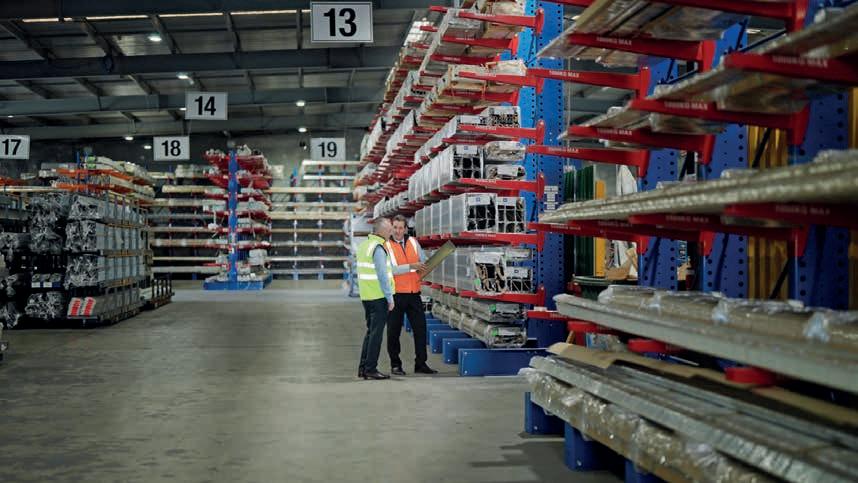
of panels that can stand up to 250-kilometre winds,” McDonald said, emphasising the robustness of their products.
Ozroll produces up to 300 roller shutters in a single shift and runs two shifts daily; with its three state-
of-the-art roll-forming machines, its commitment to quality is unwavering.
The company’s innovative spirit is best exemplified by the Ozroll Drive System (ODS), a 12-volt battery control unit that revolutionised automation in

26 Manufacturers’ Monthly April 2024 ALUMINIUM MANUFACTURING
Ozroll’s success story extends beyond innovation and growth; it includes creating jobs and showcasing Australian industry globally.
Capral
With a workforce of over 200 highly skilled employees, Ozroll exemplifies the potential of Australian manufacturing. Images:

the roller shutter industry. The L10 motor, a part of this system, was a game-changer, leading to Ozroll’s international expansion and establishing a permanent office in Frankfurt, Germany.
Adopting Capral’s low-carbon aluminium LocAl marks a new chapter in Ozroll’s commitment to sustainability. “Aluminium is highly recyclable and versatile. We’ve just started purchasing Capral’s new green aluminium LocAl. With such huge reductions in carbon emissions, LocAl is the perfect option for us,” McDonald shares, highlighting the company’s environmental stewardship.
Capral Aluminium, a key partner in Ozroll’s journey, has been instrumental in supporting and facilitating Ozroll’s growth.
“Working with Capral feels like a partnership, which we appreciate,” CEO Chris Parkinson said. T his partnership has been fortified over 15 years, with Capral providing invaluable support in areas

produce aesthetically pleasing, functional, and wellengineered products.
Ozroll’s success story is not just about innovation and growth; it’s also about creating employment opportunities and representing Australian industry on the global stage. With a highly skilled workforce of over 200 employees, Ozroll underlines the potential of Australian manufacturing. “Producing beneficial products and employing local people is very satisfying,” Zwar reflects.


Ozroll’s journey from a local manufacturer to an international player is a narrative of ambition, innovation, and unwavering commitment to quality. With the adoption of Capral’s LocAl green aluminium and a partnership that strengthens its operational capabilities, Ozroll is not just riding the wave of
Following the millennium, Ozroll experienced a substantial surge, tripling its workforce and expanding its presence nationwide.
success; it is creating it.
As the company continues to expand its reach and influence, it showcases the Australian industry’s potential to innovate, grow, and compete globally.
It’s a narrative that continues to unfold, promising new chapters of growth and success in the shade industry under the heat of the Australian sun and beyond.
To learn more about Ozroll’s story in the Crafted with Capral series, follow the QR code below.

27 manmonthly.com.au Manufacturers’ Monthly
WWW.SEMMA.COM.AU https://au.linkedin.com/company/semma-au View the video on LinkedIn We joined SEMMA primarily to connect us to other support networks in the area. Whether it’s equipment maintenance, installation, automation - SEMMA has it in spades. Nick Russo | Executive Director Bellevue Orchard, Officer VIC Member since 2015 WE SUPPORT , ADVOCATE AND CONNECT MODERN MANUFACTURING: SMART, SECURE, SUSTAINABLE
SENSOR TECHNOLOGY
Versatile object detection
SICK has introduced the W10 photoelectric proximity sensor, a ground-breaking innovation poised to redefine the landscape of automation technology. Manufacturers’ Monthly reports.
Introducing the new W10 photoelectric proximity sensor, SICK introduces a sensor solution designed to tackle a diverse array of automation tasks more universally than ever before.
With just four variants differing in operating distances and mounting options, the sensor series significantly simplifies the typical variety of types.
Leveraging a Class 1 laser light source and precise receiver evaluation line, the sensor delivers precise detection results with remarkable repeat accuracy.
For the first time, a touchscreen interface has been integrated into a sensor of this kind, meeting demanding requirements for intuitive operation, and enhancing the user experience.
Three application-optimised operating modes, along with foreground or background suppression, can be easily activated via the display.
Moreover, situation-dependent teach-in options enable convenient adaptation to individual application scenarios.
Featuring a stainless-steel housing with IP69k protection, the sensor ensures durability even in challenging environments.

With IO-Link functionality, the sensor facilitates remote configuration and seamless integration of sensor data into existing automation networks.
The W10 embodies versatility and high flexibility in application design, offering a multitude of applications across various industrial and innovation sectors, notably in factory and logistics automation.
It excels in the robust and reliable detection of objects with diverse or challenging surface properties such as gloss, colour, or texture.
Laser triangulation sensor with intuitive user experience via touchscreen
The W10 sets itself apart by eliminating the need for traditional setting elements like slide switches, potentiometers, and rotary knobs.
This innovation is made achievable through its touchscreen display, marking this laser photoelectric proximity sensor as the pioneer of its kind.
Irrespective of whether it’s speed, standard, or precision operating modes, foreground or background suppression, individual teach-in settings, preconfigured parameters, or limit values, operators
can intuitively select, access, adjust, and save all settings effortlessly.
The W10 features a screen lock as an added security measure, ensuring settings remain protected from unauthorised access or alterations by third parties. Additionally, aside from on-device operation, the W10 offers convenient configuration via IO-Link, facilitating communication through this interface.
With two digital outputs available, the W10 can efficiently deliver switching signals.
Reliable detection thanks to precise laser triangulation
The W10 integrates a class 1 laser light source renowned for its high precision. Its focused light beam creates a minimal light spot on the object, complemented by a swift and accurate receiver evaluation line.
With the aid of this advanced technology, the photoelectric proximity sensor attains exceptionally precise detection outcomes, coupled with high repeatability.
This holds true for both the short-range version,
28 Manufacturers’ Monthly April 2024
Images: SICK

covering distances from 25mm to 400mm, and the long-range variant, spanning from 25mm to 700mm.
Such capabilities make it ideally suited for accurately detecting objects and positions.
In speed mode, the response time is 1.8ms, ensuring reliable switching behaviour even at elevated machine speeds.
Teach-in option and hybrid and robust design
Through the utilisation of dynamic algorithms tailored for specific applications, the W10 achieves a superior level of reliability and consistent repeatability straight from the factory.
The photoelectric proximity sensor provides personalised teach-in capabilities for specific adjustments.
Apart from the standard 1-point teach, which identifies objects at a set distance, the 2-point teach option allows for the detection of objects with varying heights.
The manual mode broadens the teach options, providing increased flexibility.
Both the short-range and long-range versions of the W10 are offered in two housing variants: one designed for standard mounting with a 1-inch hole, and another for hybrid mounting, allowing installation either via the M18 thread on the front or the 1-inch hole on the side.

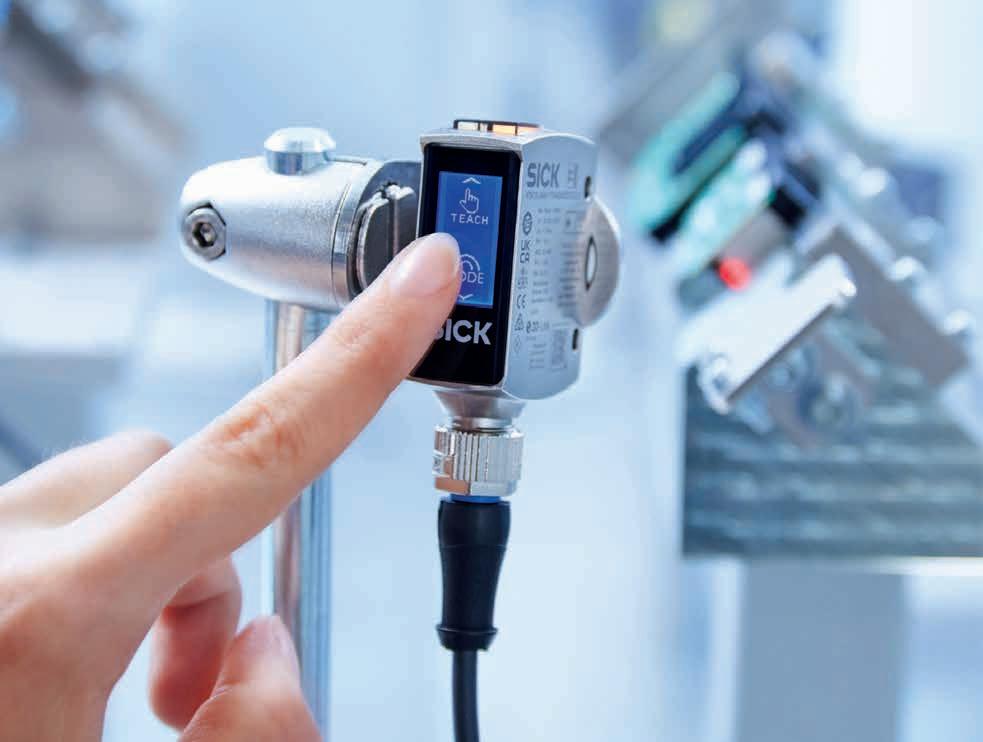
Offering two versions, each featuring dual-colour LEDs to signify the operational status, the W10 provides extensive mounting flexibility, catering to typical installation scenarios with ease.
With a stainless-steel housing boasting an IP69k protection rating, all W10 models are exceptionally rugged, capable of enduring harsh operating conditions, aggressive substances, or frequent cleaning cycles.
The
This guarantees optimal operational availability and mitigates prolonged downtimes in various applications.
SICK’s introduction of the W10 photoelectric proximity sensor marks a significant milestone in automation technology.
With its intuitive features and versatile capabilities, the W10 stands out as a pioneer in the field.







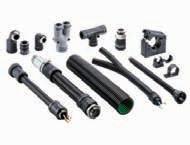





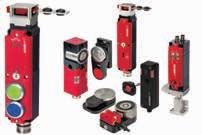
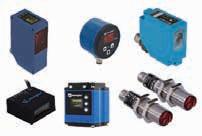




29 manmonthly.com.au Manufacturers’ Monthly
Treotham Automation • 1300 65 75 64 • info@treotham.com.au SCAN NOW FOR MORE The leading supplier of the BIGGEST names in Automation E-Chain & BearingsCables & GlandsFlexible ConduitsConnectors Safety Sensors
W10 incorporates a class 1 laser light source known for its exceptional precision.
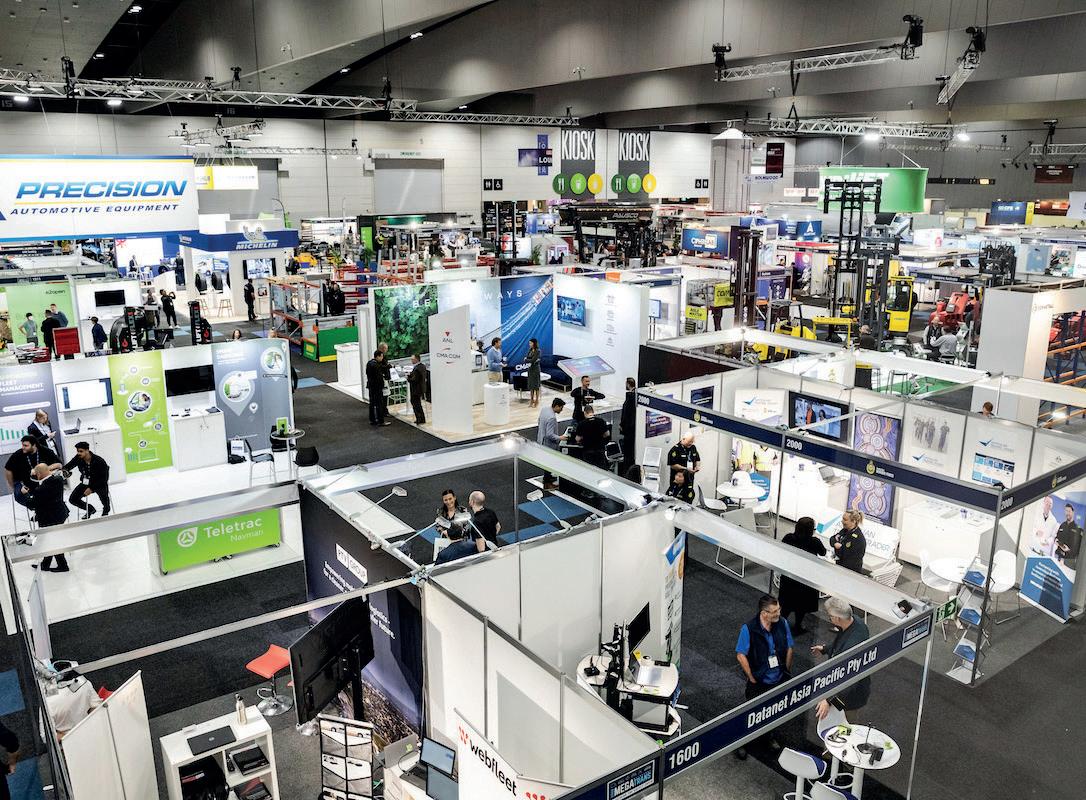
A MEGA showcase of sustainable warehouse innovation
Melbourne will host a dedicated space for leading manufacturers to help shape strategic plans in meeting the future needs of net zero warehouses. Manufacturers’ Monthly reports.
The Australian manufacturing industry is striving to reach lower carbon emission supply chains and warehouses. Leading professionals will convene at MEGATRANS to showcase and consider the imperative directions needed for the future of sustainable warehouses.
The MEGATRANS2024 expo will showcase offerings from advanced technology companies, grouped by the technologies and services they contribute to sustainable supply chains.
This interactive expo will feature new, leading, and innovative approaches, including those from companies of varying sizes.
To achieve a zero-carbon warehouse, a facility
must have a net-zero carbon footprint, meaning the warehouse has balanced its emitted greenhouse gases with equivalent reductions or offsets to ensure there are no net increases in carbon dioxide.
Net-zero carbon footprints can be achieved using energy-efficient practices and reliance on renewable energy sources, such as solar or wind power.
The objective of meeting zero carbon warehouses helps contribute to a more sustainable and environmentally friendly supply chain.
Businesses and industries are increasingly recognising the importance of addressing issues such as climate change and the prevalence of
implementing broader sustainability strategies to their manufacturing processes.
MEGATRANS is not only an expo showcasing technologies that aid in assisting zero carbon warehouses, but it also highlights new innovations emerging to the manufacturing market.
Manufacturers’ Monthly spoke with Nexobot cofounder and chief executive officer, Dominic Lindsay, a company exhibiting at the event.
Nexobot is a modular system building warehouse robotics to address the growing demands of warehousing and logistics sectors.
As a 2023 start-up Nexobot have developed a robot that travels beneath a barrier, allowing
30 Manufacturers’ Monthly April 2024 EVENTS AND CONVENTIONS
MEGATRANS is an interactive expo featuring companies offering advanced technologies and services grouped by their contributions to the sustainable supply chain.
Images: James Thomas Photography/Prime Creative Media

packages to be efficiently sorted into designed bins.
With the growing social pressures of business to establish sustainable supply chains Lindsay said, “essentially, we’ve seen the challenges that other people have had in the industry, and we’ve designed our entire business model around avoiding those challenges.”
The viewpoint, from an exhibiting company, of having a dedicated space such as MEGATRANS to discuss strategies that can help achieve net zero warehouses was emphasises when Lindsay said, “I think getting together and talking about strategies is obviously a really good idea but what we really need is spaces to exhibit technologies that are going to help people achieve that.”
Nexobot’s primary goal in participating at the MEGATRANS expo is to establish a strong presence and successfully introduce their product to the market.
The clear objective of Nexobot attending MEGATRANS is to gain exposure in launching their product into the market.
Lindsay said, “MEGATRANS is perfect for us because we’re primarily focused on working with people who are doing any sort of horizontal movement through a facility, and predominantly the moment in parcel sorting, which is exactly where

MEGATRANS is focused.”
Nexobot has just launched with their first customer offering a regional freight carrier a lowcost parcel sourcing solution.
Lindsay said, “We’re basically going to help him sort freight faster, more accurately and safer for his team.”
Another key sector Nexobot plan to intersect is cold supply chains, “we’ve designed the entire solution to work down to zero degrees. We use

the same robot both in a chiller as well as in an ambient facility,” said Lindsay.
Exhibition opportunities for MEGATRANS are still available, use your stand as an opportunity to showcase how you can contribute to achieving zero carbon warehouses. If you are interested in exhibiting and you would like to know more, please visit the official website at www.megatrans.com.au, or contact Emily Robertson on +61 422 103 119.

31 manmonthly.com.au Manufacturers’ Monthly
The integrated event, comprising of a conference, exhibition, and jobs pavilion, offers a chance for aligned suppliers and industry leaders to connect.
MEGATRANS gathers companies offering zero-carbon solutions, from electric industrial equipment to renewable energy solutions.
ENDEAVOUR AWARDS PROFILE
Recognising the development of robotic programming
The Endeavour Awards is recognised as the premier awards program within the manufacturing industry. Australian robotic programming software company, Verbotics, was awarded winner of the 2023 Technology Application Award. Manufacturers’ Monthly reports.
The Technology Application Award, proudly sponsored by Beckhoff, recognises technologies designed to enhance manufacturing processes. This category acknowledges technology providers new to the market, catering to Australian manufacturing businesses.
Winner for the Technology Application Award, Verbotics, has been innovating the way robotics are programmed for large and small manufacturers since 2019.
The company provides smart software for manufacturers to automatically program industrial robots, specialising in welding applications. The software produced is constructed directly from computer-aided design (CAD) to generate high quality collision-free welding programs.
Manufacturers’ Monthly spoke to Verbotics cofounder and technical director, Andrew Short, to find out more about the role of robot programming in the manufacturing industry, how Verbotics software programming influences the industry and the future of the company.
Verbotics software programming
Verbotics is a programming software designed to help remove skill barriers, time and effort limitations associated with programming robots.
The application of this technology has been implemented to help make robotic automation more accessible for manufacturers.
Their programming is achieved through a combination of 3D modelling, smart algorithms and intelligent decision making.
“We make smart software that automatically programs welding robots, instead of needing a human to come in and manually program a robot,” said Short.
“You can input a 3D model of what you want to weld, we will automatically identify where the weld paths are, and automatically plan all the robot motions to get the robot to the welds and perform the weld, while optimising for weld quality.”
A critical component of programming is accounting for differences between the simulation and the real world.
Verbotics addresses this accuracy through path finding, a process of using sensing technology to adjust the as-programmed welding path to be in the correct location.
Short said, “critically, we also include path finding.”
“The simulation and the real worlds are never going to match exactly, so we include using robot sensing to figure out exactly where the part is in the real world and adjust the weld path so it is in just the right spot.

A range of companies can benefit from robotic programs, making robotic programs applicable across small and medium sized enterprises (SMEs) to much larger companies.
Software programming uptake
Within Australia, many manufacturers focus on high-mix low-volume manufacturing. This process involves the production of a high variety of products in small quantities.
“Many Australian manufacturers focus on high mix, low volume type production – and their volumes are just too low to offset the cost of programming using conventional methods,” said Short.
High-mix low-volume manufacturing is commonly used in circumstances that are more unique and require specific quality process, such as welding.
Verbotics accommodates to this production type, Short said, “Our software can make it 40 to 50 times faster to program a robot, we move it from requiring a dedicated expert to a smart piece of software that a boilermaker or someone with some CAD experience can use.”
Robotic welding is a technology that many manufacturers would take advantage of if implementation costs were more achievable; robotic programming software’s make this realistic.
Verbotics is compatible with a range of automation robotics, demonstrating the breadth of opportunities for robotic programming across industries.
Short explained how robotic programming can help job training and development.
“With our software, you can take someone who’s interested in robotics and has a welding background, get them to use our software and all of a sudden, they’re now a great welder and they’re also a great welding robot programmer,” he said.
Robotic welding offers welders’ the opportunity to gain new skills through career training, providing them with additional recruitment tools.
In addition to developing the workforce’s skills, robotic programs can aid manufacturers’ production time frames, providing them greater agility and customisation abilities.
This ability to meet market segment demands was explained further when, Short explained, “You can be really reactive to customer needs, you can customise your product, you can make specific adaptations for
32 Manufacturers’ Monthly April 2024
Verbotics intuitive desktop application unlocks welding automation to a range of industries and subset manufacture’s that weren’t previously viable.
Image: Verbotics
subsections of your market and that way you can turn around robot programs as quickly as you need to meet that changing customer demand.”
Verbotics application to the manufacturing industry
Verbotics adds value to the manufacturing industry by enabling robotic welding for a variety of manufacturers who were previously unable to utilise robotic programs.
Short said, “Our greatest value is that we can unlock robotic welding automation for a whole industry or a whole subset of manufacturers that previously wasn’t viable.”
With the robotic landscape continuing to expand, Verbotics is continuing its differentiation by developing software to suit a range of industry needs.
Verbotics draws on their history of collaborating with a wide range of manufactures, including structural steel, defence and small job contract production, to design their software suitability to a variety of products.
Verbotics is addressing the integration of robotic programming into the manufacturing industry as being one integral part of a whole robotic solution for industry decision makers.
“We are just one part of a robotic solution. A robotic solution requires a physical robot, a welder, installation, and it also requires or potentially has a huge impact on your upstream and downstream processes,” said Short.
Software programs can aid in identifying physical costs of robot cells and the needed internal expertise and resources.
Short said, “I think it’s really important to have a


trusted advisor, such as a system integrator that you can work with.”
To understand and effectively utilise robotic programs the user experience is crucial. Verbotics has not taken this aspect of their technology lightly, focusing on their programs ease of use, particularly considering the challenges engineering software brings.
“It’s about how we can expose technical capability to a user in a way that will actually make their life easier” said Short.
One outstanding Verbotics success story saw a company go from installing a robot program to now consistently running multiple, demonstrating the great results of Verbotics software programming.
“They’re producing two new robot programs every single week, every shift they’re producing between 100 to 350 metres of welding using the robot and they have an arc time of 40 to 75 per cent,” said Short.
The future of Verbotics programming
Verbotics is already looking to the future with plans for sensor-based programming development.
Short said, “Currently, we go from a 3D model of a part and program based on the model. But we’re automating the programming process for some parts where you can use a 3D scanner to scan a part and we will recognise where welds should be located.”
This will enable programming to occur without the need for a 3D model.
Short said, “This is expected to be a significant game-changer in the market.”
In addition to sensor-based programming
Verbotics has plans to intersect the market further with developments for welding adjacent processes.
Short said, “We’re also looking at processes such as grinding, cladding and polishing, that are similar to welding, as areas that we’re looking to branch into in the future as well.”
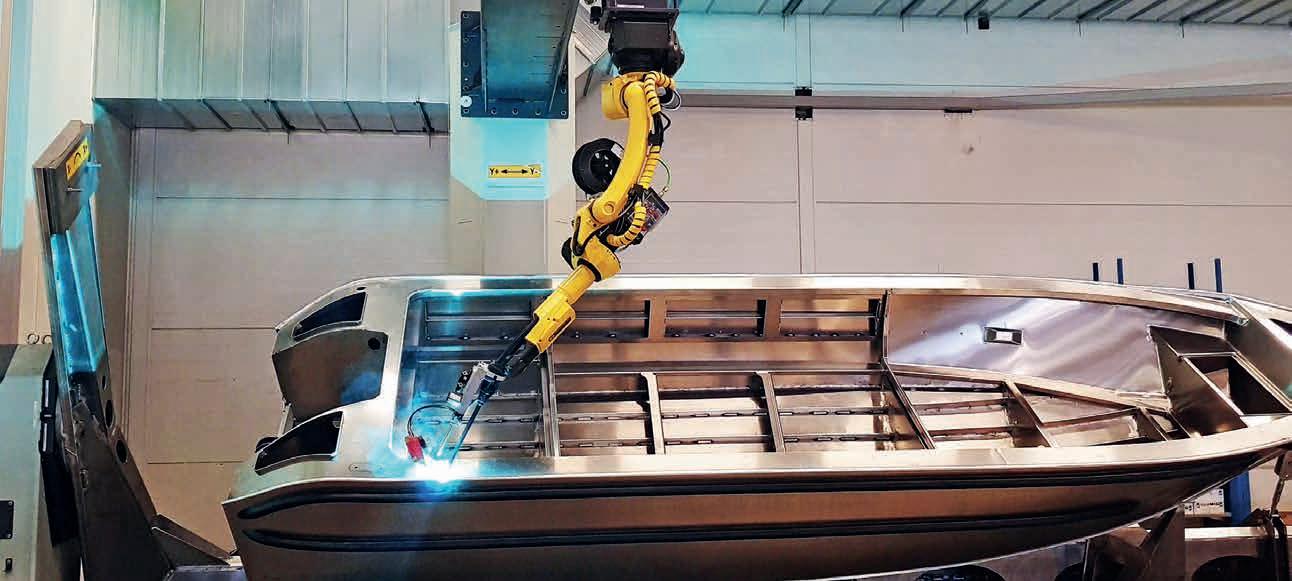
33 manmonthly.com.au Manufacturers’ Monthly
Verbotics programming software automatically generates welding programs directly from CAD information.
The success of Verbotics smart software programs is seamless in low-volume and high-mix production for small and large manufacturers.
Image: Verbotics, courtesy of the Facility for Intelligent Fabrication
Image: TDRi Robotics
COMPONENTS
Industrial automation component supply
Automation is present across various industries, and each industry demands specific and unique components. Treotham Automation’s product range aims to meet these requirements and subsequently plays a pivotal role in the machinery utilised in multiple sectors. Manufacturers’ Monthly reports.
Treotham Automation stands as one Australia’s foremost supplier of industrial automation components, catering to a diverse array of sectors.
The scope of industries leveraging automation in their production processes is expansive and multifaceted.
At one end of the spectrum, there are applications like miniature automation systems in digital printers, where components such as “Energy chain” cables, connectors, and protective housings facilitate precise movement of printer heads through computer interfaces.
Another example is the automation employed in tasks like moving arms in car wash systems.
Additionally, the company caters to large-scale enterprises involved in bulk handling, supplying essential components for machinery like cranes in shipping and port operations or stackers in mining facilities.
Targeted industries
Treotham Automation serves a wide array of industries where automation is paramount. These sectors include bulk handling, where automation facilitates efficient shipping and mining operations.
Cranes in construction sites, ports, and manufacturing facilities benefit from automation for safe and precise load handling.
Automation is crucial in food and beverage manufacturing, ensuring consistent quality and efficiency.
In food processing, there is significant demand for equipment that meets FDA standards, and Treotham provides solutions tailored to such requirements.
Machine tooling industries rely on automation for precise manufacturing processes like CNC machining.
Across various manufacturing sectors, automation streamlines production lines and improves product quality.
Mining operations utilise automation for tasks such as drilling and hauling, enhancing safety and productivity.
Packaging industries benefit from automation for efficient product packaging and labelling.
Ports employ automation for container handling and logistics management.
Offshore industries utilise automation for remote monitoring and control of offshore facilities. Railway systems rely on automation for signalling,
train control, and maintenance tasks.
Additionally, automation finds applications in robotics, safety systems, stage lighting, and entertainment industries.
Ensuring high-quality products
Treotham Automation prides itself on offering top-tier products across various categories, including cables, connectors, sensors, safety equipment, and robotics.
These products are carefully curated from globally renowned manufacturers, recognised for their unwavering reliability and long-lasting durability.
Benefiting from a dedicated team of seasoned engineers and technical experts, Treotham excels in providing comprehensive guidance and support to businesses, ensuring they select the most suitable products for their specific applications.
From offering detailed technical documentation and product specifications to aiding in installation, troubleshooting and maintenance.
Recognising the diverse needs of businesses,
Treotham collaborates closely with clients to craft tailored solutions that align precisely with their requirements.
Whether it’s devising custom cable assemblies or recommending suitable sensors for unique applications, Treotham delivers personalised assistance to meet every client’s needs.
At the forefront of technological innovation, Treotham represents market-leading organisations that continuously invest in research and development to introduce cutting-edge products and solutions to the Australian market.
Ensuring uninterrupted access to essential products, Treotham maintains robust partnerships with manufacturers and suppliers worldwide, guaranteeing a dependable supply chain.
With well-stocked local warehouses housing numerous “stock items,” businesses can rely on Treotham to provide prompt access to the products they require, minimising downtime and disruptions to their operations.
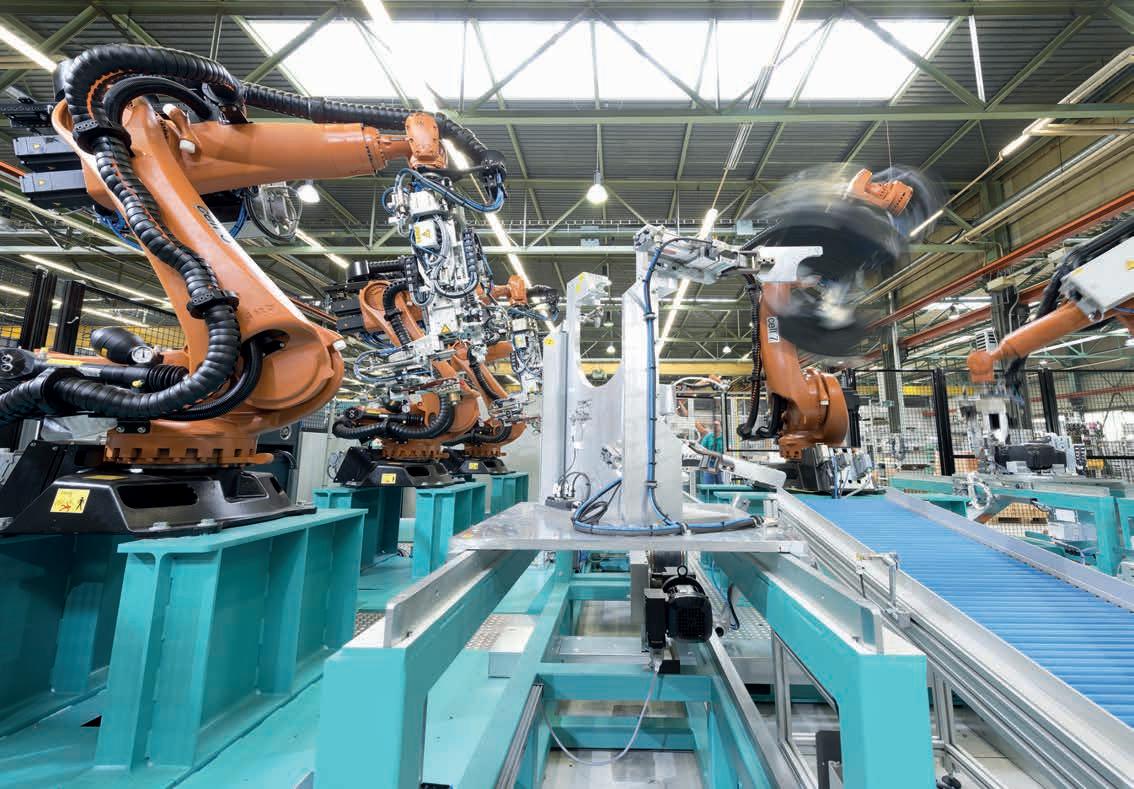
34 Manufacturers’ Monthly April 2024
AUTOMATION
Pictured above, igus triflex cable management for robots in action.
Image: Treotham
Automation components
Treotham Automation offers a diverse range of solutions tailored to optimise industrial processes.
Treotham’s Energy Chain solutions efficiently manage cables and hoses, ensuring seamless operations in dynamic environments.
The product line emphasises guidance and protection, ensuring the safeguarding of energy, data, and signals from environmental factors.
Demonstrating high compatibility, it integrates cables, hoses, interior separation elements, and other components seamlessly.
For durable and resilient connectivity, Treotham provides Flexible Cables, which are meticulously designed to withstand rigorous industrial conditions.
Treotham’s Flexible Cables represent reliability within the field of electrical engineering.
Meticulously crafted with precision, these cables deliver exceptional flexibility while maintaining durability.
Designed for dynamic applications, they effortlessly adjust to the rigours of demanding environments, spanning from industrial machinery to robotics.
Featuring innovative designs, the cables Treotham supplies ensure high performance and an extended lifespan.
Tailored to a variety of requirements, they facilitate efficient power transmission and signal control.
Whether within manufacturing plants or intricate automation systems, Treotham’s cables ensure uninterrupted connectivity, mitigating the risks of downtime.
Treotham also offers a wide range of connectors, which facilitate seamless electrical connections, enabling smooth integration within industrial setups.
Versatile connectivity options are available across various applications and industries, ensuring stable connections with premium build quality.
Tailored connectors for specific sectors, such as rail, entertainment, and stage lighting, offer specialised solutions.
Globally recognised brands like ILME, LAPP, TEN47 and Hummel provide products meeting these standards.
Treotham’s bearings are crafted to deliver reliable performance across various industrial applications.
Utilising innovative technology from Igus, Treotham employs their iglidur bar stock and tribo 3D printing techniques to reduce friction and improve wear resistance.
Their bearing range also encompasses a variety of options, from spherical to clip and slewing ring bearings, catering to a wide range of industrial needs especially in the hygienic environments.
They also offer modular linear and efficient lead screw technology, providing precise and smooth linear motion and transfer.



This versatility ensures optimal functionality across diverse operational settings, making their solutions suitable for numerous applications.
Another example from Treothams catalogue, includes flexible conduits.
Treothams flexible conduits offer exceptional cable protection, serving as a robust defence system against mechanical strains and environmental risks.
Designed for various applications, such as rail vehicles, industrial machinery, ship electrical systems, renewable energy installations, telecommunications, medical equipment, and hygienic environments, these conduits provide versatile solutions.
Treotham also offers a range of safety products, which includes emergency stops, magnetic coded sensors and more.
The assurance of optimal safety is provided through products such as safety relays and control systems, ensuring a secure and reliable environment for operations.
Adaptive solutions are offered through products like programmable controllers and time delay relays, catering to diverse industrial requirements and offering versatile safety solutions.
Quality assurance is guaranteed with certified, tested, and approved safety products, promising steadfast reliability and durability.
35 manmonthly.com.au Manufacturers’ Monthly

Indian Ocean event offers window into AUKUS and the Quad
With the foundations being laid for the largest single defence acquisition in Australian history, the Western Australian Government is presenting a national forum for discussion on both the direct effects of the nation’s planned nuclear powered submarine fleet, and the major international partnerships that will be influenced by its presence.
At Indian Ocean Defence & Security 2024 (IODS 2024), in Perth Western Australia, the geographic fulcrum between the UK, India, Japan and US, key Australian and international government, defence and industry leaders will explore the theme: Where AUKUS meets the Quad.
IODS 2024 will provide both a forum for debate and an industry exhibition showcasing the capability that will help Australia achieve its goals.
Australia, the United Kingdom, and the United States are exploring opportunities in developing joint advanced military capabilities under the AUKUS partnership, including provision of nuclear-powered submarines and development of a range of advanced technologies across all facets of defence capability.
Meanwhile regional tensions and the growing strategic importance of the Indian Ocean are also
bringing focus to Australia’s role within the Quad diplomatic partnership, between Australia, India, Japan, and the United States.
Defence West and the Perth USAsia centre have come together to curate a timely conference program which will combine specialist and VIP speakers, academics, and industry leaders as well as current and former chiefs of navy from around the world. Eight panel discussions are set to lead the conversation:
• A world adrift - global instability and the Indian Ocean;
• Implications of AUKUS for industry;
• Sheds don’t build ships - the human resources factor;
• Naval cooperation in the Indian Ocean;
• Infrastructure, Defence and Security;
• Airborne maritime domain in the Indian Ocean
• Industry’s role in securing the Indian Ocean; and,
• Lessons learned and a way forward.
The event has already attracted confirmed speakers including:
• Royal Australian Navy Chief of Navy, Vice Admiral Mark Hammond, AO, RAN;
• Admiral Sir Ben Key KCB CBE ADC, United Kingdom First Sea Lord and Chief of Naval Staff;
• Dr. Kurt Campbell, Deputy Assistant to the President of the United States and Coordinator for Indo-Pacific Affairs on the US National Security Council;
• Amb. Sujan R. Chinoy, Director General of the Manohar Parrikar Institute for Defence Studies and Analyses (MP-IDSA) in New Delhi.
36 Manufacturers’ Monthly April 2024 DEFENCE INSIGHT
AUKUS partners are shown the capabilities used during the Integrated Battle Problem 23.3 exercise at Fleet Base East, NSW, testing a range of autonomous underwater systems. Image courtesy of Defence.
Image: AMDA Foundation

Indian Ocean focus
The Indian Ocean is the world’s third largest and is bordered by nations with a combined population of around 2.7 billion, including the regions of South Asia, the Middle East, Africa’s east coast and Australia.
As a means of seaborne access for dozens of nations, and as one of the world’s busiest trade routes, the Indian Ocean is strategically significant, supporting:
• half the world’s container shipping traffic
• an estimated 40 per cent of the world’s offshore oil production
• fi ve of Australia’s top 15 trading partners.
With Indian Ocean nations developing advanced industries, the region is seeing ever increasing demand for energy and materials commodities to fuel growth.
For a snapshot of the importance of the Indian Ocean region to Australia, look no further than Australia’s own Department of Foreign Affairs and Trade (DFAT).
“Australia is an Indian Ocean country, with Perth our Indian Ocean capital,” says the DFAT’s position on the region.
“The region is essential to Australia’s security and prosperity. We have one of the Indian Ocean’s longest coastlines, the largest Search and Rescue Zone and the largest Exclusive Economic Zone. Australia is committed to promoting our vision for an open, stable, and prosperous region and to playing our part in responding to shared challenges, including climate change and maritime security.
“As a trading hub and economic highway spanning Africa, the Middle East, South Asia and Southeast Asia, the Indian Ocean is fundamental to maintaining open trade and energy security. The Indian Ocean region is also strategically significant.

Australia has an interest in a region that operates according to international rules, norms, and standards.
“Australia is strengthening its engagement in the Indian Ocean region. We have established a High Commission in Maldives and Consulate-General in Bengaluru. We hosted the 2024 Indian Ocean Conference in Perth (9-10 February), in partnership with the India Foundation and Perth USAsia Centre. We are working with regional partners to support their resilience, sovereignty, and economic aspirations. We are strengthening our engagement with the Indian Ocean Rim Association (IORA), given the importance of regional architecture to tackling shared challenges.”
AUKUS a game changer for industry
AUKUS is best known for the paradigm-changing Pillar 1 program to equip the Royal Australian Navy

with nuclear-powered, conventionally armed submarines. At an estimated $368 Billion over the life of the project, this will be the largest single defence acquisition in Australian history, delivering a platform acknowledged as the most complex moving vehicle on the planet.
But if the program delivers as promised, the AUKUS “Advanced Capabilities Pillar 2” will also offer opportunities for a broad range of Australian specialist industry, in fields from undersea capabilities to hypersonics, electronic warfare, AI and cyber.
Australian companies have already reported tuning their research and development goals and partnership aspirations to line up with the major needs of the AUKUS partnership. The Federal Government’s recently released Defence Industry Development Strategy includes multiple references to projects and strategies aimed to assist AUKUS, from workforce development, education, and training, to creating an environment for seamless transfer of technology, to enabling broader co-design, development, and production, and even ensuring the ability for AUKUS related technologies to create spill-over benefits in other sectors of the economy.
This will require changes in the way Defence does business.
“We will simplify Defence’s approach to contracting, increase its risk appetite, and shorten the time it takes to receive project and contract approvals, to deliver capability at speed while maintaining appropriate levels of governance,” says the report.
The Indian Ocean Defence & Security conference and exhibition will illustrate what that will mean for Australian diplomacy, defence and security policy, and the industry that supports it.
37 manmonthly.com.au Manufacturers’ Monthly
Image: AMDA Foundation
Image: AMDA Foundation
IODS 2024 will also feature an industry exhibition, detailing Australian and international partner capability.
The Indian Ocean Defence & Security conference and exhibition has grown to become a signature event on Indian Ocean issues.
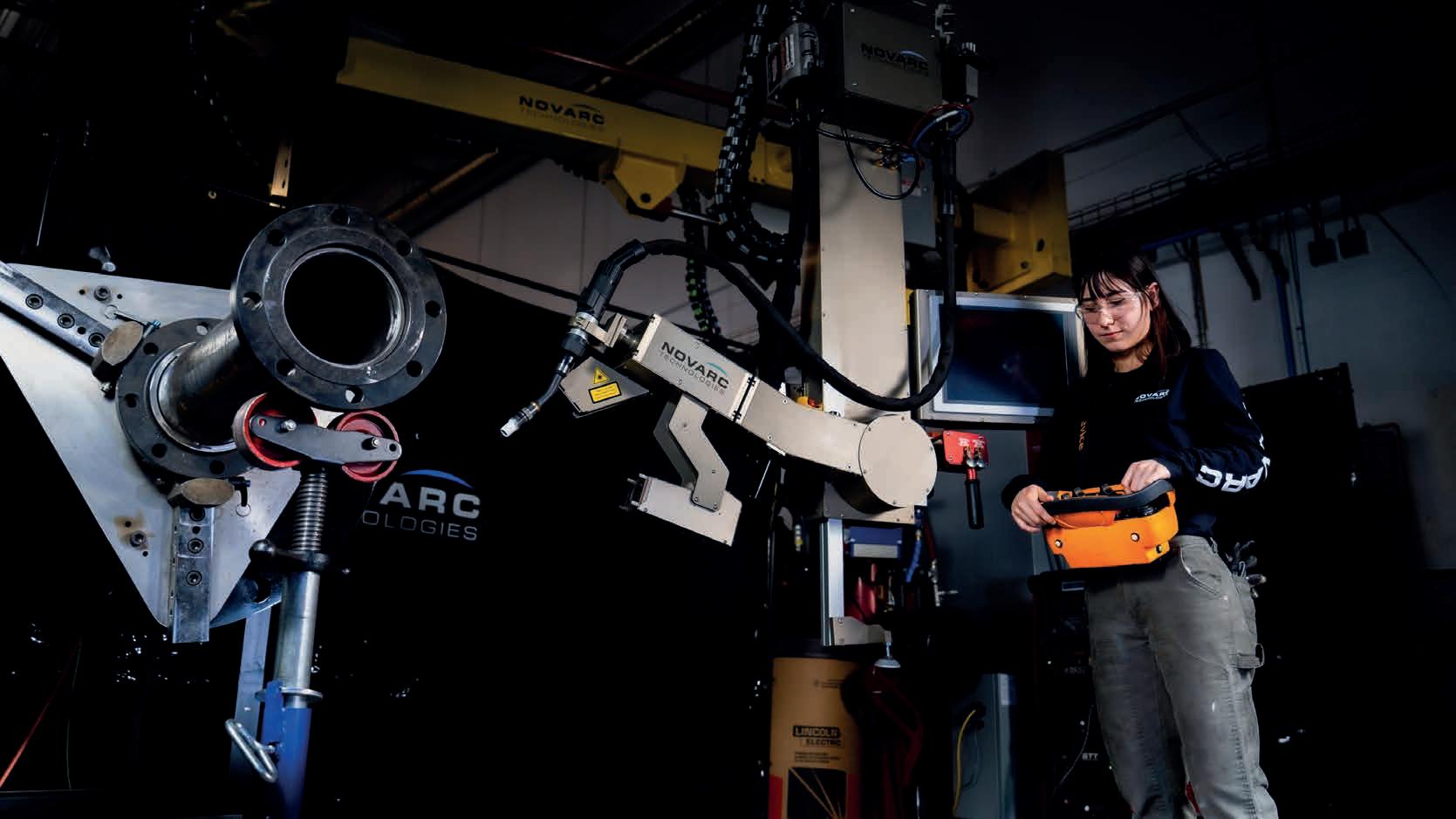
Automated welding made efficient
Novarc Technologies, a full-stack robotics company specialising in the design and manufacturing of cobots and AI systems for robotic welding applications, aims to address the shortage in welders with their autonomous SWR cobots. Manufacturers’ Monthly reports.
Novarc Technologies is a robotics company based in North Vancouver, British Columbia, Canada.
The company specialises in developing advanced robotic welding solutions for industrial applications.
Their flagship product is their Spool Welding Robot (SWR), which is designed to automate the welding process for pipe spool fabrication in industries such as oil and gas, power generation, shipbuilding, mining, and construction.
Currently, a surge in demand for pipe welding has been observed across emerging industries such as server farms, biopharma plants, and carbon capture plants, creating new requirements that did not exist previously.
Compared to more common industrial robots, the SWR has several advantages.
“The 6-axis industrial robots were programmed to do many repeat parts but when you try to use them for high mix / low volume applications, the economics of a traditional industrial robot start to break down given that the time to program those robots will be substantial compared to the actual run of the robot.”
These robots are categorised as co-operative robots or cobots for short, meaning that they can safely operate in tandem with human workers.
Manufacturers’ Monthly spoke with Soroush Karimzadeh, CEO and co-founder of Novarc; he explained that cobots were designed to address the limitations of traditional robots.
“Australia is facing critical demand of welders, and the magnitude of the problem is something that needs attention; if it’s not dealt with, it’s going to slow industry development,” he said.
Addressing shortages in welders
Geoff Crittenden, Weld Australia CEO, predicts that the Australian industry will have a shortage of up to 70,000 welders.
Rising expenses and prolonged timelines have led to significant hindrances in the construction of industrial facilities essential for fulfilling the demands of both developed and developing economies worldwide.
Adding to the complexity of this formidable challenge is the fact that pipe fabrication facilities
are responsible for providing key infrastructure to various global sectors.
This includes oil and gas, energy utilities, mining, water and wastewater management, shipbuilding, chemical, and nuclear plant construction, and maintenance, all which need highly proficient welders to manufacture key components.
Karimzadeh explained that Novarc was inspired to design and manufacture cobots specifically to address this impending shortage.
“The problem we are solving for our customers is that they are having to rely on a scarce supply of skilled welders to be able to meet the demands for pipe welding, and this collaborative robot as a tool, can help human welders be much more productive,” he said.
“We worked with initial customers in the oil and gas industry, based in Alberta, Canada, who were wanting to see the pipe welding process automated.”
“We worked closely with them to better understand the problem they were trying to solve, the needs, the production flow, and how it could be instrumental to their business and their success.”
38 Manufacturers’ Monthly April 2024 WELDING IN MANUFACTURING
Images: Novarc

Novarc’s SWR is the world’s first collaborative welding robot, offering pipe fabrication shops a collaborative welding automation alternative that addresses the scarcity of welding labour, which can change how clients approach bidding on projects.
The SWR streamlines the pipe welding procedure, operating in tandem with a human operator, to enhance productivity, weld precision, and uniformity. This can enable clients to potentially recoup their capital investment within a span of six to 18 months.
Success stories
A notable example of Novarc’s cobot success is its partnership with Kleeberg, a company specialising in sheet metal and mechanical services.
By incorporating SWR into their operations, Kleeberg significantly improved welding efficiency and productivity, showcasing the practical impact of Novarc cobots in manufacturing settings.
“The adoption of the SWR allowed Kleeberg to complete welding tasks on 12-inch pipe joints in just 10 minutes, a substantial improvement over previous timelines.”
Novarc cobots have also contributed to cost and labour savings, operational efficiency, and technological leadership advancements.
“Kleeberg realised significant cost savings per weld, approximately $25 for smaller pipes and around $45 for larger pipes, alongside a notable decrease in labour costs by 12-15 per cent,” Karimzadeh said.
“The implementation of the SWR contributed to a 12-15 per cent timesaving in Kleeberg’s operations, highlighting the operational efficiency gained through this technology.”
“With 95 per cent of their welding now conducted using the SWR, Kleeberg has positioned itself as a frontrunner in industrial efficiency and technological adoption, setting new industry standards in welding productivity and quality,” Karimzadeh explained.
This case study demonstrates how Novarc’s cobots effectively tackle distinct manufacturing obstacles, resulting in notable enhancements in productivity, efficiency, and cost-effectiveness.
The cobots can ultimately catalyse a transformative impact on conventional industrial processes.
Implementing cobots
In explaining the distinct advantages of using cobots, Karimzadeh explained that they can seamlessly integrate into customers’ production flows and existing manufacturing processes.
The SWR is designed to be easily integrated into a wide range of pipe fabrication shops, accommodating different layouts, and meeting specific operational requirements with flexibility and ease.
“It’s basically designed to be minimally intrusive to the production flow. It’s designed to work with positioners’ existing equipment that customers technically have worked with before and understand,” Karimzadeh said.
“Novarc provides its own positioners but in terms of existing processes, we’re following the same roll welding processes as many of our customers use and in addition, we are changing it up from manual welding to mechanised weld and robotic welding.”
“We also have a very accommodating set of requirements for our fit-up process, and we provide training for fitters.”

Novarc cobots adhere to the ISO 15066 standard for collaborative robots and their applications.
ISO/TS 15066:2016 outlines safety standards for collaborative industrial robot systems and their operating environments.
It provides additional requirements and guidance to ensure safe operation of collaborative industrial robots.
These cobots are equipped with force and speed limiting sensors, ensuring that in the event of a safety incident, they can safely halt operations.
Due to the inherent design of Novarc’s cobots and the fact that the torch is controlled by the cobot itself, operators are kept at a safe distance from hazardous welding fumes.
Cobots effectively mitigate exposure to various welding hazards, including harmful fumes like manganese and hexavalent chromium.
The cobots ensure that operators do not need to be in direct contact with welding fumes, unlike conventional manual welding methods where operators are closer to the arc.
“Another benefit in terms of safety, is that going from manual to mechanized, the operator’s hand won’t get fatigued, and humans will be spared from the long-term hazards of doing this work,” Karimzadeh said.
“As a tool, Novarc’s cobot can work with the limited team of welders available today in Australia and can allow them to be 3-5X more productive on carbon steel and 10-12X more productive on stainless steel welds so our technology definitely will help with the labour shortage.”
Embracing technology
The upcoming phase of development involves the “smartisation” of Novarc’s cobots, which entails leveraging data to create intelligent systems capable of delivering autonomous adaptive welding solutions to address welding variations. A significant portion of these solutions relies on computer vision artificial intelligence.
Novarc is also now in the process of adapting the foundational models and intelligence developed for SWR’s to other applications.
This effort aims to provide various industries with the benefits of the same perception, cognition, and reaction capabilities offered by the SWR.
“This is of course only available with the latest advancements of computer vision, AI and the data that Novarc has from thousands of hours of welding with spool welding robots as well as the compute power that is available today,” Karimzadeh said.
“We are excited to see new capabilities of SWR unlocking new ways for our customers to adopt it in their production facilities.”
39 manmonthly.com.au Manufacturers’ Monthly
Cobots are designed to handle repetitive tasks with precision and consistency, helping to streamline processes and reduce errors.
AGRICULTURE FARMING EDUCATION
WASTE MANAGEMENT RESOURCE MANAGEMENT CONSERVATION MANUFACTURING RESOURCES
AGRICULTURE FARMING EDUCATION WASTE MANAGEMENT RESOURCE MANAGEMENT CONSERVATION MANUFACTURING RESOURCES
ENERGY HEALTH & SAFETY INFRASTRUCTURE ENGINEERING MINING CONSTRUCTION
ENERGY HEALTH & SAFETY INFRASTRUCTURE ENGINEERING MINING CONSTRUCTION
QUARRYING AGRICULTURE FARMING EDUCATION
QUARRYING AGRICULTURE FARMING EDUCATION
WASTE MANAGEMENT RESOURCE MANAGEMENT CONSERVATION MANUFACTURING RESOURCES
WASTE MANAGEMENT RESOURCE MANAGEMENT CONSERVATION MANUFACTURING RESOURCES
ENERGY HEALTH & SAFETY INFRASTRUCTURE ENGINEERING MINING CONSTRUCTION
ENERGY HEALTH & SAFETY INFRASTRUCTURE ENGINEERING MINING CONSTRUCTION
QUARRYING AGRICULTURE FARMING EDUCATION
QUARRYING AGRICULTURE FARMING EDUCATION
WASTE MANAGEMENT RESOURCE MANAGEMENT CONSERVATION MANUFACTURING RESOURCES
WASTE MANAGEMENT RESOURCE MANAGEMENT CONSERVATION MANUFACTURING RESOURCES
ENERGY HEALTH & SAFETY INFRASTRUCTURE ENGINEERING MINING CONSTRUCTION
ENERGY HEALTH & SAFETY INFRASTRUCTURE ENGINEERING MINING CONSTRUCTION
QUARRYING AGRICULTURE FARMING EDUCATION
QUARRYING AGRICULTURE FARMING EDUCATION
WASTE MANAGEMENT RESOURCE MANAGEMENT
WASTE MANAGEMENT RESOURCE MANAGEMENT
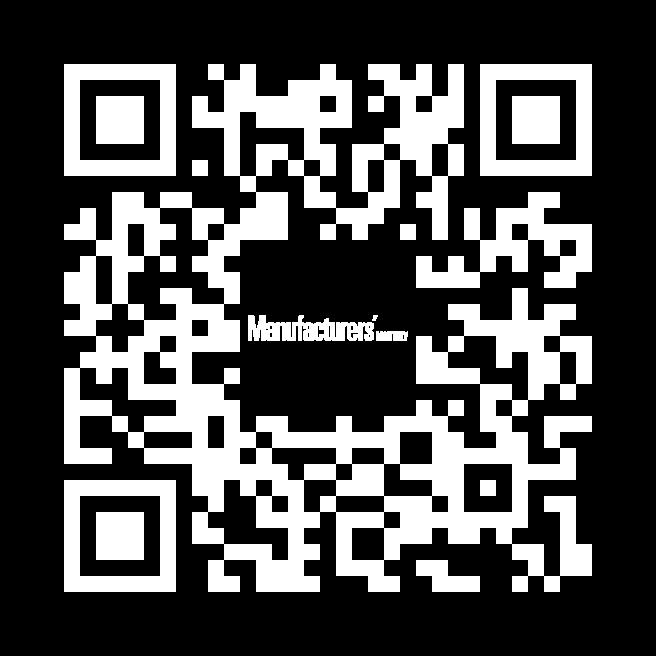
SEARCH FOR TOP INDUSTRY TALENT THROUGH OUR JOBS BOARD.
SEARCH FOR TOP INDUSTRY TALENT THROUGH OUR JOBS BOARD.
CONNECT WITH ALIGNED CANDIDATES.
CONNECT WITH ALIGNED CANDIDATES.
BOOST YOUR CHANCES OF FINDING SKILLED APPLICANTS.
BOOST YOUR CHANCES OF FINDING SKILLED APPLICANTS.
SCAN TO CREATE AN ACCOUNT TODAY AND DISCOVER YOUR PERFECT MATCH!
SCAN TO CREATE AN ACCOUNT TODAY AND DISCOVER YOUR PERFECT MATCH!




Lean, green lifting machines
Find out how Combilift’s latest electric innovation – the Combi-CB70E – is taking both operational efficiency and operator comfort to the next level.
Since developing world’s first engine-powered multidirectional forklift – the C4000 – Irish manufacturer Combilift has not taken its foot off the innovation pedal. And having recently celebrated its quarter-century anniversary in 2023, the company marked the occasion with the debut of several exciting new products.
One such product, the Combi-CB70E, is the latest addition to Combilift’s range of electric machines. Launched alongside a handful of new products, including the Combi-CUBE, as part of the manufacturer’s 25-year celebrations, the bright green multi-directional forklift is a testament to Combilift’s commitment to innovation.
Colin Gray, Combilft’s regional manager for Norway and Finland, said the CB70E combines both well-established and newly developed features to set a new bar for lifting efficiency – even in tough conditions.
“We see a lot of applications such as sawmills where the yards aren’t paved, so operators are often dealing with rough surfaces and potholes,” he said. “With the CB70E’s extra-large wheels, we see applications like these as a huge potential market
for us. That’s a big reason we launched the machine at the Ligna international timber and woodworking show in May 2023 – and we’ve had a lot of interest in it since then.”
Compact power
Combining a 7000kg lift capacity with a small footprint and excellent manoeuvrability, the CB70E has been designed to enable operators to move bulky loads more easily in tighter areas.
“Typically, counterbalanced forklifts will measure 3.5m from the face of the fork the back of the machine,” Gray said. “So, operators will need a certain amount of clearance if they’re turning into an aisle with a load of timber. With the CB70E, that measurement is 2.68m – almost a metre smaller.”
Combined with the CB70E’s multi-directional design, Gray said, the manoeuvrability benefits are essentially doubled.
“We see this as a huge benefit in both timber and steel applications,” he said. “For anybody handling awkward loads of seven tonnes or more, manoeuvrability is key.”
Another stand-out feature of the CB70E is its
Red Dot Award-winning independent traction system, which eliminates the need for differential lock on slippery surfaces and reduces long load momentum twisting when travelling laterally.
“Depending on the steering angle, this system is programmed to ensure every wheel is always rotating at the correct speed,” Colin said. “This results in reduced tyre wear, as well as better traction in rougher terrain.”
Elevating ergonomics
Given many industries are still wrestling with skilled labour shortages, operator comfort has become a point of renewed focus for many equipment manufacturers. With operators spending such long hours in their machines, the ergonomic design of cabins and controls are essential to minimise physical strain and fatigue – a benefit to both productivity and site safety.
“In the past, operators might have commented that our forklifts didn’t have the same comfort features as some of our competitors,” Colin said. “But with its bigger wheels and comfortable cab, we see the CB70E as fully comparable with any
41 manmonthly.com.au Manufacturers’ Monthly MATERIALS HANDLING IN MANUFACTURING
Combilift
With a 7000kg lift capacity, compact design, and excellent maneuverability, the CB70E facilitates moving bulky loads in tight spaces. Images:
other counterbalanced forklift in the market in terms of ergonomics.”
What separates the CB70E from the forklift pack is its gas strut suspension cabin, which uses components often found in larger-scale industrial machinery. Combined with Combilift’s superelastic tyres, operators can be ensured a smoother experience, even on rougher surfaces.
Another newly developed feature, the CB70E’s Auto Swivel Seat, automatically swivels 15 degrees to the left or right, depending on travel direction. This helps both maximise visibility for the operator, and reduces physical strain when reversing.
According to Mark White, research and development manager – and Combilift’s first ever employee – this innovation came to him and his team while travelling on a business trip.
“We were travelling back home and discussing ways we could improve safety and comfort for operators,” he said. “And we came up with this idea whereby the seat would rotate automatically according to the direction of travel, taking the strain off the operator’s body and neck.”
White said the Combilift team’s freedom to innovate stems in part from its deeply ingrained positive company culture – one that has seen many key personnel stay with the company for multiple decades.
“There’s a group of people that have been here for the full 25 years, and quite a lot that have ticked over 20 and 15 years,” he said. “All those people have grown with the company, and have helped maintain a culture where everyone comes together with their ideas. It makes for a very ‘can-do’ attitude throughout the company – from the upper management all the way down.”
Electric future
The vibrant green colour scheme of the CB70E is not just a safety feature – it’s indicative of Combilift’s focus on developing more environmentally friendly options for the industries it serves.
In fact, more than 70 per cent of Combilift’s in-production vehicles are now electric. And, according to CEO and Co-founder Martin McVicar, electric equipment is now the focus of about 98 per cent of the company’s research and development (R&D) resources.
“As a company, we’re inherently focussed on sustainable solutions,” he said. “We’re focussed on making vehicles that are more environmentally friendly to use, as well as vehicles that enable our customers to make their warehouse utilisation more environmentally friendly.
“The increased capacities that we are offering in
our electric range will answer the demand for ever more powerful products, while at the same time helping companies to achieve their aims for more sustainable operations.”
It’s this commitment to minimising environmental impact that has driven Combilift’s use of lead-acid instead of lithium batteries – a decision that might seem at odds with the industry at large.
But it’s for one very good reason: recyclability. According to CSIRO, lithium waste remains a problem without a solution – only 10 per cent of Australia’s lithium-ion battery waste was recycled in 2021, as opposed to 99 per cent of the lead acid equivalent.
“We’re going to continue to grow our business organically with a key focus on R&D and building products that adhere to our three pillars: improving safety, maximising storage, and increasing efficiency,” McVicar said.
It’s a sentiment shared by Mark, who adds that keeping in touch with the needs of the end user is paramount.
“We listen to our customers, and we pay attention to what’s needed in the market,” he said. “And we just keep on developing.” Combilift will fully supply lithium-ion trucks to customers upon request, recognising the industry’s anticipated growth to accommodate lithium recycling.

Over 70 per cent of Combilift’s current vehicle lineup in production is now electric-powered.


42 Manufacturers’ Monthly April 2024


DO YOU KNOW A DRIVER OF CHANGE?
WOMEN IN INDUSTRY NOMINATIONS ARE NOW OPEN. Now is your chance to nominate an industry leader who you believe is advocating for positive change and deserves to be recognised.
PROUDLY PRESENTED BY MHD
Thurs 20 June, 2024
The Women in Industry Awards recognise outstanding women leaders from across Australia’s industrials sector.
womeninindustry.com.au
PROUDLY SUPPORTED BY Australia
Supply Chain Solutions

New land tax unjustified, says SEMMA
South East Melbourne Manufacturers Alliance (SEMMA) – a non-profit organisation representing the interests of manufacturers in South East Melbourne – has commented on the recent land tax introduced by the Victorian Government to offset COVID debt and has called for an inquiry into the process of calculation of Land Value and Land Tax. Manufacturers’ Monthly reports.
SEMMA plays a crucial role in advocating for the manufacturing sector, promoting growth, innovation, and collaboration among its members.
The organisation provides support, resources, and networking opportunities to manufacturers, aiming to enhance their competitiveness and sustainability in the local and global markets.
Recently, SEMMA members have expressed concerns regarding Victoria’s COVID debt repayment land tax, particularly regarding transparency in the process of calculation of Land Value and Land Tax.
As part of its 2023-24 State Budget, the Victorian Government introduced a COVID Debt Repayment Plan, which includes changes to land tax and payroll tax.
According to the 2023-24 COVID Debt Repayment Plan, the estimated value of the COVID debt amounts to approximately $31.5 billion.
This includes expenditures made and revenue lost by the state, adjusted for Commonwealth Government co-contributions.
These financial activities primarily took place between the years 2019-20 and 2022-23.
Starting from the 2024 land tax year, alterations have been made to the rates and thresholds based on the total taxable value (site value) of landholdings.
Land valued between $50,000 and $100,000 will incur a flat surcharge of $500, while land valued between $100,000 and $300,000 (or $250,000 for trusts) will face a flat surcharge of $975.
For land valued over $300,000 (or $250,000 for trusts), a $975 flat surcharge will be imposed in addition to an increased land tax rate by 0.10 percentage points.
According to a recent survey conducted by SEMMA, some Victorian manufacturers have experienced land tax increases of over 50 percent compared to last year.
The survey highlighted a significant rise in one member’s tax bill from 2023 to 2024.
Moreover, in 2023, with a land value of $3.75 million in Dandenong, the land tax amounted to $47,100.
By 2024, despite the land value increasing to $4.3 million, the land tax for this member had surged to $66,100.

44 Manufacturers’ Monthly April 2024 ASSOCIATION COMMENT
The South-eastern Melbourne region contributes 30 per cent of the nation’s manufacturing output, spanning various sectors.
Images: SEMMA
In another case highlighted by the survey, a different member situated in Hallam experienced a significant change in their property’s valuation and subsequent land tax obligations.
In 2023, the property was valued at $4.2 million, resulting in a land tax of $58,575.
By 2024, the property’s valuation increased by 55 per cent to $8.5 million, leading to a corresponding increase in land tax to $177,400.
SEMMA CEO, Honi Walker, said the decision to increase the land tax was not justified.
“There is no justification for these increases in land value. How can the State Government substantiate exorbitant increases of 50 per cent and above in Land Value within twelve months and then charge land tax on that new value?” said Walker.
“Manufacturers are being gouged by the State Government. We kept the state’s economy ticking over during COVID as manufacturing was designated an essential service. We continued to pay everincreasing taxes plus an increase in Work Cover premiums in some cases over 70 per cent – you name it we paid it,” Walker continued.
“Now we are being asked to cover a debt that we did not create. There is no justification for this land tax increase on manufacturers.”
Consequences of land tax
The South-eastern Melbourne region generates $43bn in gross regional product, hosts 50 per cent of Melbourne’s manufacturing jobs, employing 267,500 people, and provides 30 per cent of the nation’s manufacturing output.
The Victorian manufacturing industry is an essential part of the state economy, contributing to employment, innovation, and economic growth.
It encompasses a wide range of industries, including automotive, aerospace, food and beverage, pharmaceuticals, and advanced manufacturing.
Victoria’s manufacturing sector has historically been one of the largest in Australia.
Walker explained that the land tax will ultimately have cascading effects on the Victorian economy, not just manufacturers.
“Members have responded, quite emotively about the challenges imposed by the land tax in our survey,” she said.
“Some of our members have had increases in the last five years of 300 per cent in their land tax, which is going to have a flow on effect.”
“They won’t be able to invest in capital equipment, they won’t be able to hire new people, they may also have to let people go and then of course, they will have to increase their prices,” Walker continued.
Walker stated that manufacturers may be forced to close-up their businesses or move interstate to maintain their operations.
Moreover, she explained that if manufacturers are significantly impacted, everyone above and below
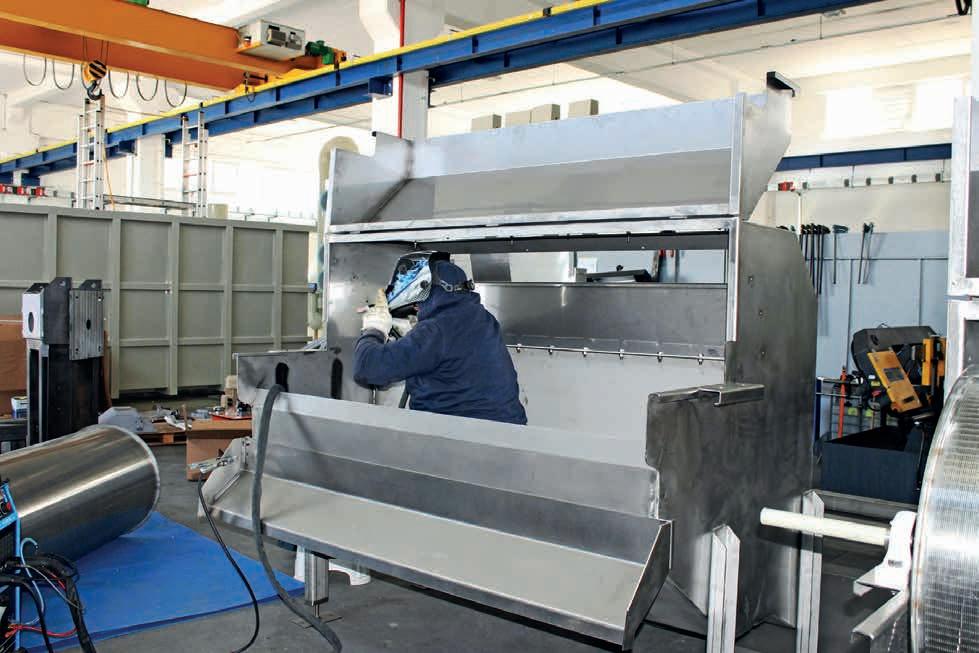
the line will be affected. Ultimately, the customer will have to pay more.
“We won’t really know the fallout of this land tax probably for another six months, and then we’ll start to see buildings for sale, and forced closures,” said Walker.
“All of these costs to do business are then passed on to the end user, which is the consumer at the end of the day.”
“It’s not good for anybody at all, the State Government has to do something to address their COVID debt without singling out manufacturers,” Walker continued.
Land tax inquiry
In response to the land taxes, SEMMA is calling for an inquiry into the process of calculation of land value and land tax on Victorian manufacturers.
Walker expressed that SEMMA members are ultimately seeking more transparency from the State Government.
She continued to express that Victoria’s COVID debt burden should not be shouldered by the manufacturing sector indefinitely and that penalising profitable businesses, which are the backbone of our
state’s economy, is unsustainable.
“Someone has to pay for the COVID debt, but we just don’t think it should all have to come from manufacturers,” she said.
“It certainly would help if the Victorian Government were to review the land tax for manufacturers, it could go a long way to improving the relationship between government and business.”
Walker emphasised that SEMMA is dedicated to advocating for all its current and future members struggling to deal with the challenges of land tax. With a dedication to promoting growth and innovation within the manufacturing sector, SEMMA stands ready to support and champion the interests of its members, fostering a collaborative environment for mutual success.
SEMMA accepts members from diverse sectors across the manufacturing industry, including but not limited to agriculture, automotive, construction, chemical, defence, electronics, food, health, information technology, machinery and equipment, marine, medical, mining, petrochemical, pharmaceutical, plastics, textiles, and transportation.
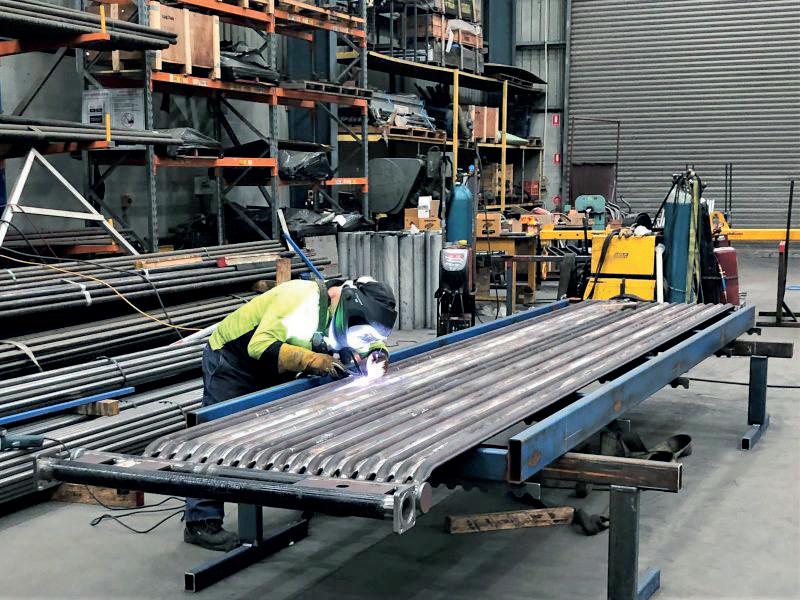
45 Manufacturers’ Monthly
The Victorian manufacturing industry is vital for employment, innovation, and economic growth, historically being one of Australia’s largest.
The rise in land tax could hinder investment in capital equipment, limit job creation, and potentially lead to layoffs and price increases.

Platinum ERP Solutions from BusinessHub
BusinessHub aims to empower manufacturers with tailored enterprise resource planning (ERP) solutions, focusing on modernisation, scalability, and deep industry expertise. Learn about their commitment to continuous learning, their recent accolades, and future advancements. Manufacturers’ Monthly reports.
BusinessHub is recognised as a MYOB Advanced Platinum Partner, specialising in the MYOB Advanced Manufacturing Edition.
Their focus lies in serving mid-market manufacturers, particularly those engaged in maketo-order, make-to-stock, assembly, and value add, and batch manufacturers.
They place emphasis on providing enhanced visibility around inventory planning and management, including quality, scheduling, and procurement.
Key features of their MYOB Advanced solution include robust quality management, comprehensive scheduling capabilities, and an in-depth product configurator tailored for environments requiring configurable products.
Their overarching goal is to drive operational efficiency and streamline workflows for their clients in the manufacturing sector.
BusinessHub specialises in make to stock, assembly and batch manufacturing including speciality food and ingredient producers and beverage makers.
They support wholesale distribution businesses involved in assembly or value-added processes, where they combine multiple products or enhance smaller products.
“So, assembling those together into multiple products variants and bringing smaller products into a bigger overall solution for their customers,” said David Taylor, Managing Director at BusinessHub.
Additionally, they extend their services to equipment manufacturers for transportation and logistics.
Helping clients overcome obstacles
Typically, a client will approach BusinessHub seeking to modernise their existing solutions.
They often express a desire to transition from legacy or older on-premises systems to cloud-based platforms facilitating connectivity and access to insightful data.
Some clients may find their current solutions inadequate, particularly if they are using multiple disjointed applications.
“Clients often want to move to cloud because they’re currently using on premise and older solutions in market,” said Taylor.
“They may have solutions that are, frankly, too small and just aren’t meeting their needs.”
These challenges may also include difficulties in integrating data across different systems, resulting in a loss of visibility into crucial metrics such as margins
and input costs.
Clients may also face complexities in managing external processes and maintaining quality control standards.
Additionally, they seek improved inventory visibility to enhance planning and procurement processes.
Finally, BusinessHub specialises in assisting clients operating in multi-company environments, streamlining processes across multiple entities.
“We’re strong in automating processes across multiple entities and then consolidating that data in a single view,” said Taylor.
In explaining the advantages of data accessible through as a single view, Taylor explained, “It enables multiple company structures to be viewed as a single entity or a single group.”
“Intercompany transactions hyper inflates sales and purchases, so really eliminating and then consolidating data into a single view.”
They have the capability to seamlessly facilitate intercompany transactions, even when the stock exists in a different entity.
“We can automate that workflow end to end, which just drives a lot of efficiency in their administration while still meeting their compliance requirements,” said Taylor.
46 Manufacturers’ Monthly April 2024 ERP SOLUTIONS
Image: pressmasterstock.adobe.com

Clients often want to move to cloud because they’re currently using on premise and older solutions in market.
”
Taylor emphasised the importance of understanding clients’ objectives and pain points.
Moreover, he underscored the necessity of comprehending clients’ current workflows and investing time to align with their needs, which can vary based on factors like location complexity and product scope.
“We spend time with the client to go through that to ensure we can best enable their processes,” said Taylor.
BusinessHub focuses on enabling the application to meet clients’ specific requirements and desired outcomes.
This phase includes training and testing to ensure seamless integration with clients’ operations.
“We have basic training delivered through our E-learning platform and that’s a platform that we developed ourselves for the MYOB Advanced Manufacturing Solution, then we’re into bespoke user training, which is based on our clients’ specific workflows and processes,” Taylor said.
“That training is delivered generally done physically in-person with our customer, supported by workflow documents and workflow procedures, that both are adapted from within the core application as well as with the client.”
Ultimately, the goal is to empower clients, equipping them with the knowledge and tools to effectively utilise the application.
Taylor explained the significance of knowledge transfer and ongoing support to facilitate tasks such as financial reporting, procurement, and shop floor management, ensuring clients achieve their desired outcomes.
ERP success stories
Taylor has observed several key markers of success that have been achieved by clients using their ERP solutions.
“What our clients are seeing is a more optimised handling of their stock, which results in improved management of working capital,” he said.
“They just don’t have the wrong stock sitting in their warehouse, that’s obviously a big one.”

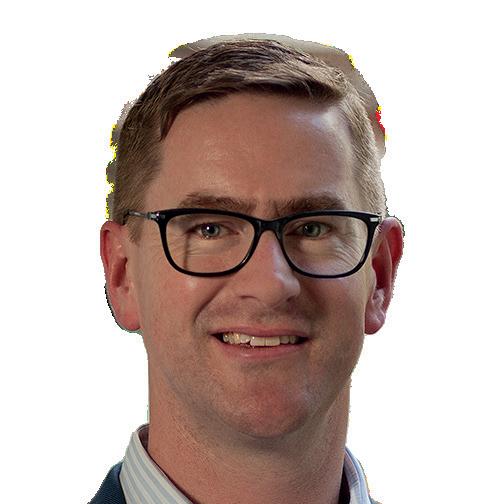
“Our ERP solutions enable our clients to unlock capacity, so they can do more within with what they’re working with.”
Taylor explained that BusinessHub is concerned primarily with the growth of their clients.
“We track our client success through growth, not the commensurate growth in human resource underneath it, but being able to optimise those workflows a lot better,” he said.
Customisable and scalable solutions
Taylor said that BusinessHub solutions are entirely and scalable to meet their clients’ diverse needs.
“What we’re trying to do with our customers, where possible, is to help them use best practice workflows within the application, where that’s possible and appropriate as opposed to approaching the deployment of a solution and trying to customise it upfront,” he said.
“Our clients typically want a scalable solution that continues to upgrade over time, and trying to stay away from bespoke customization is a goal for ourselves and should be a goal of our clients.”
Taylor explained that the configuration of the application itself is standardised and intuitive.
“In terms of getting into the details to configure workflows and bespoke elements in those workflows is quite straightforward within the application using various user defined fields or tweaks to processes, which we don’t deem as customisation,” he said.
Developing ERP
To stay up to date with developments in ERP, BusinessHub spends a lot of time at conferences amongst industry experts.
“We spend a lot of time at industry events, and we really get into the detail with the vendor around the underlying framework and capability of the solution,” said Taylor.
“In addition to that, we’ve also then returned from MYOB Partner Connect, conference at the start of February.”
“At the conference, we maintained our Platinum Partner Status and took home Manufacturing Partner of the Year and Customer Service Partner of the Year.”
Taylor explained that the primary focus for BusinessHub when participating in conferences is to remain updated with advances in digital transformation.
“Where we’re at those conferences, the big focus now is unlocking knowledge and understanding in addition to finding solutions to further improve client outcomes in the verticals we service,” he said.
“In addition, there is a lot being discussed about secure and useful tools using artificial intelligence and machine learning capability both within the product and connected into the core workflows.”
Looking to the future
To evolve their services for the future, BusinessHub is currently looking to grab bespoke solutions and fill gaps within the core product.
“That might be around enhancing tooling around container management, or more enhanced inventory management. We’re also dealing with tools around b2b e-commerce integrations,” said Taylor.
Enhancing tooling for information exchange and product customisation demands can pose challenges for the company.
However, BusinessHub is actively working on tools to navigate these challenges and seamlessly integrate them into ERP solutions.
The company is also aiming to enhance process manufacturing capability.
“We anticipate these enhancements to be implemented in the second half of this year, enabling us to better serve process manufacturers,” said Taylor.
“Specifically, within dairy, health, beauty, food, and pharmaceutical sectors.”
To learn more about BusinessHub and their ERP solutions, please reach out at 1300 733 071.
47 manmonthly.com.au Manufacturers’ Monthly
David Taylor founded BusinessHub in 2003, specialising in implementing and supporting MYOB Exo Employer Services, MYOB’s payroll and HRIS software.
Image: BusinessHub
“

Navigation systems for vehicle autonomy
Australia-based manufacturer, Advanced Navigation, believes its new light detection altimetry and velocimetry (LiDAV) technology could substantially improve contemporary navigation systems. Manufacturers’ Monthly spoke to the Head of Photonics, Dr. Lyle Roberts, to learn about the capabilities of their technology, and its future applications.
Advanced Navigation is an Australia-based manufacturer that specialises in developing high-precision technology for various applications, such as marine systems, automotive, aerospace, defence, and robotics.
The company received a $1 million dollar grant to accelerate the development of their latest tech, LiDAV.
The Minister for Industry and Science Ed Husic announced the award under Round 15 of the Cooperative Research Centres Projects (CRC-P) grant initiatives.
The CRC Program aims to facilitate partnerships led by industry, fostering collaboration among industry stakeholders, researchers, and the community.
Dr. Lyle Roberts explained that LiDAV is a technology that has been designed to augment the performance of existing conventional navigation
systems, primarily when operating without Global Navigation Satellite System (GNSS) or Global Positioning Systems (GPS).
LiDAV is designed to work symbiotically with an inertial navigation system (INS), which fuses data from multiple sensors to determine a vehicle’s position and orientation over time.
“One way of thinking about LiDAV is as a way to continue navigating reliably when GPS is down. And there’s several reasons why GPS could be disabled,” he said.
Manufactured in Advanced Navigation’s newest production facility in Sydney, the technology presents a solution for measuring range and velocity across a variety of vehicles.
Vertical take-off and landing (VTOL) aircraft and ground vehicles are particularly well-suited for its application.
With the rise of autonomous vehicles and compatible guidance systems, the precision and adaptability offered by LiDAV are poised to expedite the adoption of this technology.
Innovating navigation
Traditional navigation systems like GPS, however, require a clear sight of the sky. Without it, the systems cannot be utilised accurately.
Moreover, there are inherent limitations to using GPS in certain conditions, like in underground environments.
Roberts explained that their LiDAV technology could be used to guide ground vehicles as an additional aid when GPS cannot be used.
Common navigation technologies such as Doppler radar, LiDAR, and camera-based visual systems possess inherent limitations and frequently
48 Manufacturers’ Monthly April 2024 ENGINEERING FOCUS
Images: Advanced Navigation

necessitate collaborative operation to mitigate these constraints.
For instance, camera-based systems struggle to function reliably in low or no-light conditions. Likewise, environmental factors such as dust or the substrate itself can compromise the reliability of LiDAR and radar systems.
LiDAV, however, is impervious to interference including ambient light availability, material surface properties, and bright light sources that could blind other sensors such as the sun.
Beyond its superiority in GNSS-denied settings, LiDAV offers advantages in scenarios where accurate, instant awareness of a vehicle’s ground-relative altitude and orientation is vital.
LiDAV can operate independently of external signals or systems, rendering it also highly resistant to jamming.
“What’s interesting is it’s not just active when GPS is disabled, it will actually help you to detect when GPS is being jammed,” said Roberts.
Jamming refers to the action of employing a transmitting device operating on a specific frequency to disrupt or obstruct radio communications.
Addressing design challenges
Advanced Navigation collaborates with various industries, including mining, defence, and aerospace, to integrate LiDAV technology into their operations.
For instance, through its partnership with companies like Transparent Earth Geophysics (TEG), Advanced Navigation aims to enhance mineral exploration through improved positioning and velocity measurements.
“TEG wants to use LiDAV to actually augment and enhance the GNSS positioning and measurements of velocity for airborne mineral surveys,” said Roberts.
Roberts explained that TEG’s mission is to locate mineral deposits underground by measuring gravity.
“If there is a deposit of a precious mineral underground, flying over it with a sensor highly sensitive to acceleration would detect a change in gravity,” he said.
“If this process is repeated ten times and consistently yields a significant fluctuation, it indicates there’s something interesting underneath. This method has been successful in identifying such deposits.”
“But conventional instruments are the size of a dishwasher,” Roberts chuckled.
A new technique has been developed utilising extremely precise velocity measurements; this method compensates for the random motion of the plane caused by air turbulence.
“It’s a new type of technology, and we’ve really had to innovate to reduce its size, weight and power.”
“The technique allows them to reduce the size of that instrument so that you can now fly it on a drone,” said Roberts.

“That’s a really, really special highlight customer that we are working with actively now to understand how that will work.”
LiDAV in aerospace and defence
In aerospace, it addresses challenges faced by drones and unmanned aerial vehicles (UAVs), providing GNSS resilience and enabling autonomous navigation in GPS-denied environments.
“A big focus for us is to develop LiDAV for UAV applications,” said Roberts.
“You can provide this capability to people who operate drones for a variety of purposes – one could be just surveillance, another could be for something as ordinary as agriculture.”
“LiDAV adds that layer of protection, because a lot of drones, as soon as they lose access to GPS, they’ll go home. But the problem is, if they don’t have GPS, they can’t find home.”

Roberts explained that Advanced Navigation has already received several expressions of interest from companies seeking to utilise their LiDAV tech.
“We’re finding that drones are becoming larger and larger, and far more dangerous. So, having that safeguard that allows you to navigate reliably, is super important,” explained Roberts.
In defence applications, it also serves as a countermeasure against GPS jamming and spoofing, ensuring continued autonomous operation even in hostile situations.
“Looking at the unfortunate situation in the Middle East, and in Ukraine; GPS and GNSS is broadly denied,” said Roberts.
“Planes often avoid flying in those regions to avoid GPS denial.”
“When they’re operating drones for surveillance, or for other purposes they don’t have any ability to navigate reliably, except by pilot.”
LiDAV enhanced spaceflight
Advanced Navigation’s patent-pending LiDAV technology offers a pathway for spacecraft to autonomously take off and land while maintaining a considerably smaller size and weight compared to similar technologies.
LiDAV promises substantial cost reductions and enhances the safety and reliability of commercial spaceflight.
Ensuring the reliability of sensor and navigation technology is paramount for any autonomous system, particularly in the context of autonomous space missions.
Advanced Navigation has collaborated with industry experts to enable enhanced navigation in spaceflight.
With their partner, Intuitive Machines, Advanced Navigation is enabling NASA spaceflight missions with LiDAV.
LiDAV is assisting Intuitive Machines, a major player in NASA’s Commercial Lunar Payload Services (CLPS) program, to enhance the safety and reliability of autonomous landing manoeuvres on the lunar surface.
This ultimately aims to advance the industry’s mission to bring humans back to the Moon.
“Intuitive Machines recently returned the United States to the Moon after more than 50 years, successfully landing on the lunar south pole,” said Roberts.
“This company is, I would say, the front runner in NASA’s CLPS programme, which is aimed at supporting the Artemis mission.”
Roberts explained that Intuitive Machines will also utilise Advanced Navigation’s LUNA (Laser m easurement Unit for Navigational Aid) technology.
Like LiDAV, LUNA assists in navigation where GPS signals are unavailable, ensuring safe autonomous navigation during descent.
49 manmonthly.com.au Manufacturers’ Monthly
Compact, integrated flight systems are crucial for reducing spacecraft weight, seamlessly integrating into the guidance navigation and control system.
ENGINEERING FOCUS
“It’s fully autonomous, there’s no piloting at all. You can’t pilot a spacecraft from Earth because of the time delay. So, the sensors are used to land without any human input.”
How it works
In short, the LiDAV system uses lasers to measure a vehicle’s velocity.
The core elements comprising the LiDAV sensor include the laser, modulator, telescope, and optical receiver.
The technology accurately measures distance and velocity using minimal hardware compared to similar systems.
Laser-based distance/range and velocity measurement refers to technology that utilises laser beams to determine the distance to an object or target. LiDAV measures velocity by exploiting the Doppler effect.
This method usually involves emitting a laser towards a particular target, then measuring the time it takes for that light to reflect to the sensor.
By analysing the time-of-flight of the laser pulse, the distance of said target can be accurately determined.
“The sensor measures the vehicle’s velocity in three dimensions with extraordinary accuracy,” said Roberts.
“The reason we can do this so accurately, is because it uses lasers, which are extremely sensitive to Doppler.”
“By measuring velocity directly, you’re only one step away from estimating position.”
Typically, lasers with higher power levels have the

capability to measure greater distances.
Modulators are employed to manage or alter the phase, amplitude, and frequency of the laser.
A modulator is a device or component used to modify a signal in some way.
In contemporary telecommunications systems, modulators play a crucial role in embedding data/ information onto laser light.
The modulator translates a pseudo-random pattern from an electrical signal into the phase of the emitted light, generating a modulation waveform within the laser beam.

A pseudo-random pattern refers to a sequence of values that appear randomly but is generated using a deterministic algorithm or process.
This encoded pattern introduces a time-varying characteristic to the light, enabling the determination of time-of-flight.
Additionally, it facilitates the correlation and comparison of modulated waveforms between the emitted and reflected laser light.
Modulators in modern telecommunications encode data onto laser light by imprinting a pseudo-random pattern from an electrical signal onto the light’s phase.
This creates a modulation waveform in the laser beam, enabling the determination of time-of-flight and facilitating comparison between emitted and reflected laser light.
An optical receiver is employed to measure the data encoded onto laser light, including its amplitude or phase.
This device converts captured light photons into electrons, essentially transforming light into electrical current.
The future
Roberts envisions that Advanced Navigation’s LiDAV technology will become a standardised navigation tool across several industries.
“We envision this technology becoming a standard addition to nearly every drone platform, regardless of the model,” he said.
“Furthermore, we anticipate this technology’s adaptation for use in larger, higher altitude platforms, including helicopters.
“By providing precise velocity measurements during landing, it enables automated landing sequences, enhancing platform stability.”
50 Manufacturers’ Monthly April 2024
In aerospace, it tackles challenges encountered by drones and UAVs, offering GNSS resilience and facilitating autonomous navigation in GPS-deprived environments.
LiDAV offers a solution for measuring range and velocity across different types of vehicles.













For over 59 years, Manufactures’ Monthly has lead and informed Australia’s manufacturing industries with its highly creditable editorial analysis of the market. manmonthly.com.au MANAGEMENT >> TECHNOLOGY >> SOLUTIONS SiteHive Hexanodes ifm efector IO-Link Spacesuitdesign manmonthly.com.au MANAGEMENT >> TECHNOLOGY >> SOLUTIONS APRIL 2024 Verbotics automation software SICK proximity sensor LiDAV from Advanced Navigation Visit the Manufacturers Monthly website to subscribe to the magazine or to view the digital edition. For all the latest news including government announcements and breaking news follow us on social media and subscribe to the newsletter by scanning the QR code. www.manmonthly.com.au For more information, contact Emily Gorgievska 0431 330 232 Manufacturers Monthly Manufacturers’ Monthly Manmonthly

4 SPONSORSHIP OPPORTUNITIES NOW! OPEN RECOGNISING AUSTRALIA’S BEST MANUFACTURERS endeavourawards.com.au 07.11.2024 MELBOURNE SPONSORED BY

BST presents iBase’s SI-663 13th/12th Gen Intel Core Processor signage player
Backplane Systems Technology is pleased to present IBase’s SI-663. In the rapidly evolving digital signage market, iBase’s SI-663 stands out as a powerhouse, offering a blend of cuttingedge technology and robust design to meet the demanding requirements of modern digital displays.
At its core, the SI-663 is powered by the latest 13th/12th Gen Intel Core processors, which, when combined with Intel Iris Xe display chips, provide exceptional performance, energy efficiency, and superior visuals. This makes the SI-663 an ideal choice for a wide range of applications, from retail advertising to informational displays in public spaces.
The SI-663 is not just about raw power; it also emphasizes smart energy management with its iSMART technology, enabling power on/off scheduling and power resume functions. This, along with the Observer advanced remote monitoring technology, ensures that the digital signage player can be easily managed and maintained, reducing downtime and operational costs.

Connectivity is another strong suit of the SI-663, featuring HDMI 2.0, DP++ 1.4, and DVI-D interfaces, along with USB 3.2 ports and multiple M.2 expansion options for 5G/LTE, WiFi, and Bluetooth capabilities. This allows for unparalleled flexibility in installation and ensures that the SI-663 can meet the specific needs of any digital signage application. Security and reliability are paramount in digital signage, and the SI-663 delivers on both fronts with TPM 2.0, vPro technology, and a watchdog timer. Its industrial-grade design, including a separate flow ventilation system, ensures that the SI-663 operates reliably even in challenging environments
Weighing just 1.5 kg and offering versatile installation options, the SI-663 is a compact yet powerful solution that supports a range of operating systems, including Windows 10 IoT Enterprise and Linux Ubuntu. Whether for advertising, information dissemination, or entertainment, the iBase SI-663
digital signage player is designed to deliver top-notch performance and reliability.
Key features:
• iSMART intelligent energy-saving technology
- enables power on/off scheduling and power resume functions
• Supports 13th/12th Gen Intel Core processors
• 1x HDMI 2.0 / 1x DP++ 1.4 / 1x DVI-D
Company: Backplane Systems Technology
Phone: (02) 9457 6400
Website: backplane.com.au
ICP Electronics Australia presents ICP DAS I-7530A-MR-FD
Modbus RTU to CAN converter
ICP Electronics Australia is proud to introduce ICP DAS I-7530A-MR-FD. The ICP DAS
I-7530A-MR-FD stands as a pivotal component in the integration and expansion of industrial automation systems, bridging the gap between Modbus RTU protocols and CAN networks. This Modbus RTU to CAN converter is fully aligned with the ISO 11898-2 standard, ensuring seamless interoperability and high reliability in demanding industrial environments. Its robust feature set includes support for CAN bus acceptance filter configuration, firmware updates via RS-232, and a utility tool for module settings and CAN bus communication testing, making it an indispensable tool for engineers and system integrators. Users can benefit from the built-in jumper for 120Ω terminal resistor selection and the hardware watchdog design, ensuring consistent and secure operations. The I-7530A-MR-FD excels in versatility with modes that support direct conversions between CAN messages and specific ASCII command strings, transparent communication via CAN bus in pairconnection mode, and comprehensive Modbus
functionalities, including slave and master modes. Designed for a wide array of applications such as control systems, building automation, factory automation, and distributed data acquisition, the I-7530A-MR-FD is equipped to handle urgent CAN messages with dedicated memory space for up to 100 kinds of messages.
Key features:
• Fully compatible with ISO 11898-2 standard
• Support CAN bus acceptance filter configuration
• Support firmware update via RS-232
• Provide utility tool for module setting and CAN bus communication testing
• Built-in jumper to select 120Ω terminal resistor
• Hardware Watchdog design
• Convert CAN message to specific ASCII command string (Normal mode)
• Convert specific ASCII command string to CAN message (Normal mode)
• Provide the transparent communication between the RS-232/485/422 devices via CAN bus (Pairconnection mode)

• In Modbus Slave mode, supports function code
• Support Modbus Master function
• Support CAN FD
Company: ICP Electronics Australia
Phone: (02) 9457 6011
Website: icp-australia.com.au
53 manmonthly.com.au Manufacturers’ Monthly WHAT’S NEW
Image:
Backplane System Technology

THE LAST WORD
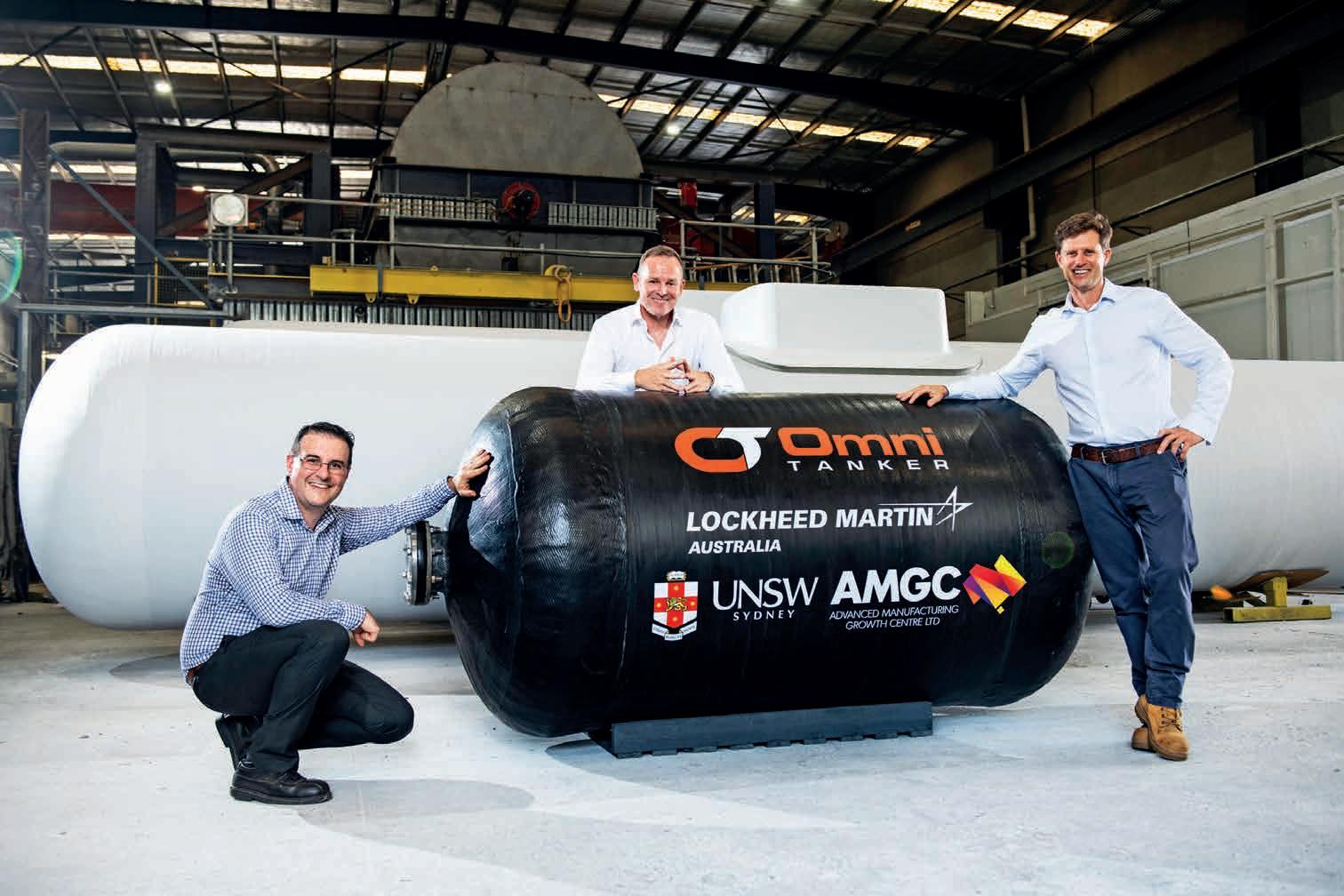
What is industry?
Industry is everything. Australia is well known and substantially rewarded for its primary industries of mining, agriculture, and other raw commodities. Those commodities are a windfall profit for our country; we didn’t do anything to get them in the first place – they were just there and that’s why we are lucky, not capable.
The value-adding part of industry – called manufacturing – transforms these primary commodities into goods and services that local and global customers need. Only this capability of making things will be the difference between short-term gain and long-term prosperity, particularly once our raw commodities are no longer in demand or replaced by other suppliers.
Australia is a rich country, ranked number nine in global wealth per capita. Yet, we rank number 93 out of 133 nations in what we export in terms of complex things being made – manufacturing. We simply do not add enough value to our major export commodities – and sooner rather than later, global customers will no longer buy a big portion of what we are shipping today.
I have made this clarion call to lift our industry’s capability and complexity since 2015 – almost 10 years, and I am sad to report that our country’s industry report card is not straight As.
Industry can be incredibly capable, but unless it is matched with complexity the job is only half done. Why leave cards on the table by being capable of digging or growing something, while not extracting more value on offer by adding smarts?
Harvard measures each country’s smarts every year. As mentioned above we rank 93rd. A position that has fallen 38 points since the Harvard Growth Lab started the Economic Complexity Index (ECI) in 1995. Interestingly, at that time, China and Australia were hovering around the 50 mark. In almost 30 years, China, which is now the 46th richest nation per capita, has increased its complexity position to 18. Meanwhile, Australia languishes 43 points behind its nearest OECD country, Greece which ranks 50th.
This places Australia’s Economic Complexity between Uganda and Pakistan. Unlike Australia, Uganda, the 126th richest country, and Pakistan, the 116th richest, have both improved their economic
complexity over the past 30 years.
Surely, this should make us mad. We would not accept the same paltry performance in our sporting endeavors – but we continue to accept that our industry is not supported and cheered on with the passion it deserves.
I have seen and AMGC has identified and coinvested in very smart manufacturers. We needed many of them during the pandemic and many manufacturers across the country stood up and asked how they could be of service.
Now, we need to harness that cooperation and think about true manufacturing excellence. Besides, many Australian companies, manufacturers or otherwise, lack scale and need a leg up, and there’s the immediate strategy available to us to assist and that’s connecting the dots rather than remaining siloed.
Advancing manufacturing is about connecting the dots.
54 Manufacturers’ Monthly April 2024
Image: AMGC
JENS
GOENNEMANN - MANAGING DIRECTOR ADVANCED MANUFACTURING GROWTH CENTRE
Contrary to a deeply wired view, manufacturing is not a sector. It is an interconnected ecosystem of capabilities that cut across every sector in the economy where something is made – be it food, furniture, or fabricated goods.
Complexity is the point of difference that separates a nation that simply wishes to make things from a nation that makes things that the world needs. Complexity is the ability to make highly sophisticated goods that will drive positive economic and social outcomes, and which achieves a good price.
Take Germany for example, a country that has little access to readily available raw materials, yet it is a manufacturing powerhouse. Germany has a rather resilient economy. It makes complex things the world pays for spanning a broad remit of products and services. Japan, Korea, Austria, Sweden, the US and more recently China are in the same boat.
Australia is the opposite. We have vast natural riches that have made us complacent. As a result, our ability to make complex things has been in decline. Digging and shipping by comparison is relatively easy hence, the paltry ECI ranking of 93.
Now I say relatively, because there are a lot of smarts and innovations involved in extracting commodities, but we leave so much opportunity on
the table by not adding value.
So how do we change this trajectory?
Our first action should be to take a strategic best approach. Unlike other complex economies, we do not have the breadth of capabilities to turn our hand to say semiconductors overnight, however, we do have many opportunities.
Take our country’s commitment to reach Net Zero by 2050 and aim to reach emission levels of 43 per cent below 2005 levels by 2030. If we want to be a leader in hydrogen – an alternative energy source, then we need to make, transport, and use hydrogen. While we have sun, wind, and water and potentially the equipment to make hydrogen, we have no immediate or obvious way to store and move it –until now, and here comes the smarts.
We must look for adjacent capability – or connect the dots – and we found it in a very innovative manufacturer in South-West Sydney called Omni Tanker. This manufacturer makes complex carbon composite vessels to transport caustic liquids by road. We then asked them if they could turn their minds to hydrogen storage for space and they said yes – and there was the ideal customer.
It is not fanciful. With support from AMGC, Omni Tanker is working with the global aerospace
company Lockheed Martin and late last year announced that they have developed a tank for the transport and use of hydrogen.
This is just one example of how connecting the dots and encouraging manufacturers to apply their smarts and skills to adjacent verticals benefit Australian jobs, capability, and prosperity.
Doing more of what we have in the past will not move the complexity needle. Using the untrue excuse that we are a high-cost labour market, which Japan, Austria, Sweden, and Korea are as well, will not help either.
What we do need is the public and political will to take control of our fortunes. We need to better understand that once we lose capabilities, you cannot just flick a switch and turn them back on. We need to make the best widgets in the world, and it must be for the global audience – and we need to help small yet highly capable manufacturers to scale.
Australia’s ability to change the trajectory on our complexity and capability is not impossible. It will not be easy either. One thing is for certain: the longer we wait, the more we risk becoming nothing more than the world’s quarry, farm, and hotel – we are better than that.
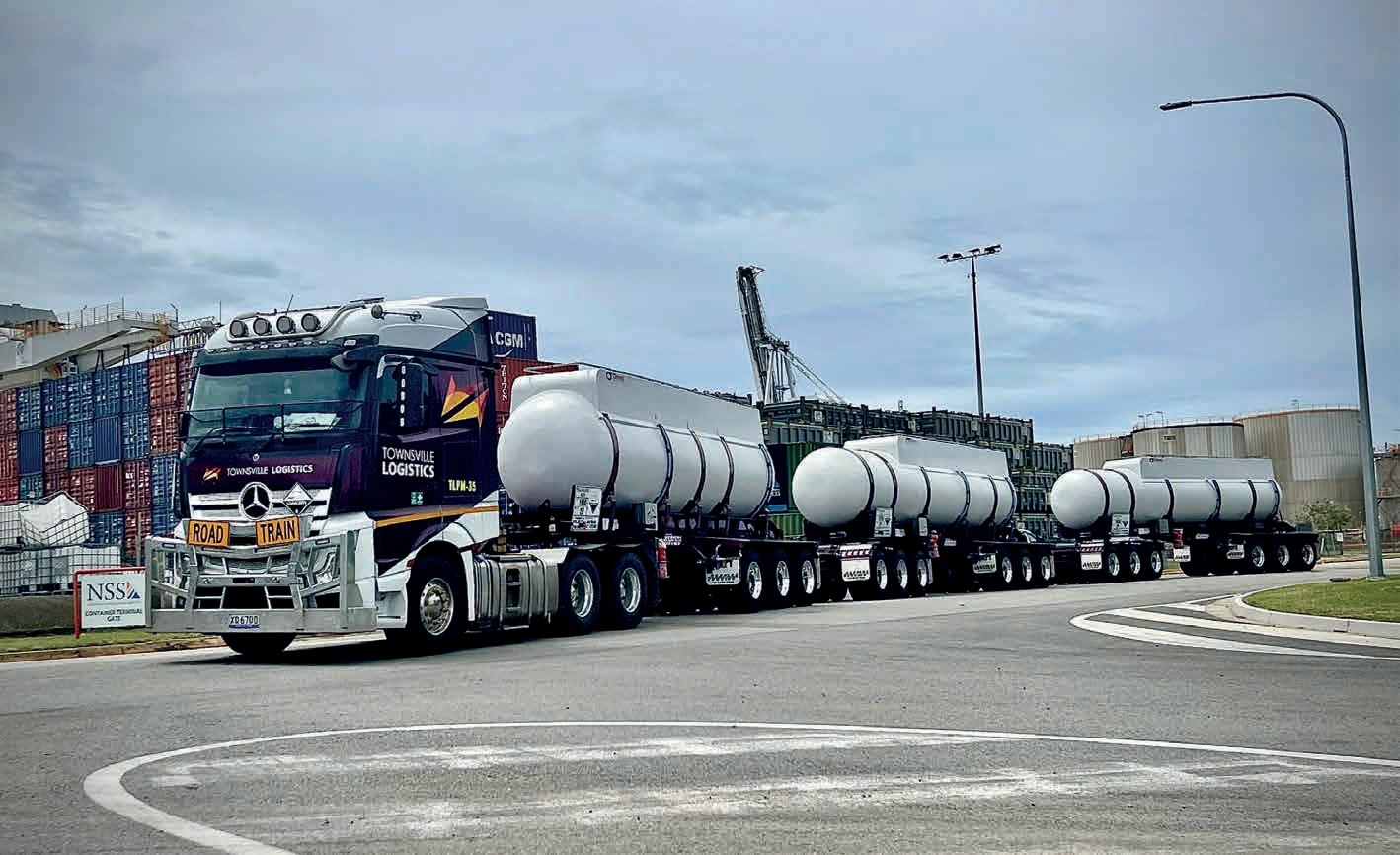
55 manmonthly.com.au Manufacturers’ Monthly
Omni Tanker’s composite road tankers in use in the mining industry.
COMPLETE AIR & POWER SOLUTIONS
CAPS Australia has been supplying best-in-class air and power solutions to the manufacturing sector for more than 44 years.
Specialising in end-to-end solutions, our in-house engineering allows us to design, supply and install bespoke, purpose-built systems to clients with specialised applications. As an independent company with the flexibility to search globally for the best technology,
CAPS works alongside world-renowned partner brands like Ingersoll Rand, Mitsubishi, AIRMAN, Kohler and many more.
With ten branches nationwide and 24/7 service for maintenance and emergency breakdowns, CAPS Australia leads the industry in service and solutions.



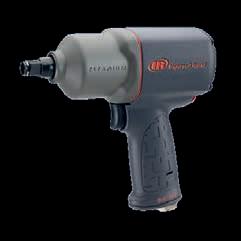


CALL 1800 800 878



GENERATION
& SPARE PARTS
COMPRESSORS
CLASS 0 OIL-FREE AIR AIR TREATMENT
POWER
SERVICING
AIR
POWER ISO
OR VISIT CAPS.COM.AU





































































































































